Antenna Systems in Medical Masks: Applications for 5G FR1 and Wi-Fi 7 Wireless Systems
Abstract
:1. Introduction
- A small number of wearable devices are designed with antennas that include Wi-Fi and 5G communication frequency bands [18] or use Wi-Fi and LTE frequency bands for data transmission [19,20]; other antennas are even designed with three different frequency bands [21]. However, the design of the antenna is too complicated and the area is too large so that the antenna is not suitable to be installed in the wearable device;
- For indoor and outdoor use at the same time. A variety of antennas are required to support different frequency bands to achieve a high broadband transmission rate and good transmission path reliability;
- Under the premise of meeting the aforementioned characteristics, the size of the antenna needs to be further miniaturized;
- Design the antenna system on the flat and curved positions of the wearable device;
- The antenna system needs to have good robustness, so that it can be used on different composite materials or placed on a flat or curved surface, without much design difference.
2. Antenna Design
2.1. Antenna Evolution
2.2. Effect of Antenna Branch
2.3. Surface Current
3. Antenna Analysis
3.1. S-Parameters Analysis of Antennas
3.2. Gain and Efficiency of Antenna
3.3. Radiation Pattern
3.4. ECC Simulation and Analysis
4. Human Body Effect Analysis
4.1. Human Head Model
4.2. Analysis of Free Space and Wearing Head
4.3. Simulation and Measurement Analysis of Wearing on Head
4.4. Specific Absorption Rate (SAR) Simulation Aanalysis
4.5. Performance Comparison with Other Antennas
5. Conclusions
Author Contributions
Funding
Conflicts of Interest
References
- Ometov, A.; Shubina, V.; Klus, L.; Skibińska, J.; Saafi, S.; Pascacio, P.; Flueratoru, L.; Gaibor, D.Q.; Chukhno, N.; Chukhno, O. A survey on wearable technology: History, state-of-the-art and current challenges. Comput. Netw. 2021, 193, 108074. [Google Scholar]
- Dachyar, M.; Zagloel, T.Y.M.; Saragih, L.R. Knowledge growth and development: Internet of things (IoT) research, 2006–2018. Heliyon 2019, 5, e02264. [Google Scholar] [PubMed] [Green Version]
- Ahsan, M.; Teay, S.H.; Sayem, A.S.M.; Albarbar, A. Smart Clothing Framework for Health Monitoring Applications. Signals 2022, 3, 113–145. [Google Scholar] [CrossRef]
- Paracha, K.N.; Rahim, S.K.A.; Soh, P.J.; Khalily, M. Wearable antennas: A review of materials, structures, and innovative features for autonomous communication and sensing. IEEE Access 2019, 7, 56694–56712. [Google Scholar] [CrossRef]
- Park, S.-M.; Kim, Y.-G. A Metaverse: Taxonomy, components, applications, and open challenges. IEEE Access 2022, 10, 4209–4251. [Google Scholar] [CrossRef]
- Ratcliff, J.; Supikov, A.; Alfaro, S.; Azuma, R. ThinVR: Heterogeneous microlens arrays for compact, 180 degree FOV VR near-eye displays. IEEE Trans. Vis. Comput. Graph. 2020, 26, 1981–1990. [Google Scholar] [CrossRef]
- Lavric, A.; Petrariu, A.I.; Mutescu, P.-M.; Coca, E.; Popa, V. Internet of Things Concept in the Context of the COVID-19 Pandemic: A Multi-Sensor Application Design. Sensors 2022, 22, 503. [Google Scholar] [CrossRef] [PubMed]
- Vavrinsky, E.; Zavodnik, T.; Debnar, T.; Cernaj, L.; Kozarik, J.; Micjan, M.; Nevrela, J.; Donoval, M.; Kopani, M.; Kosnacova, H. Research and Development of a COVID-19 Tracking System in Order to Implement Analytical Tools to Reduce the Infection Risk. Sensors 2022, 22, 526. [Google Scholar] [CrossRef] [PubMed]
- Siriwardhana, Y.; Gür, G.; Ylianttila, M.; Liyanage, M. The role of 5G for digital healthcare against COVID-19 pandemic: Opportunities and challenges. ICT Express 2021, 7, 244–252. [Google Scholar] [CrossRef]
- Ahad, A.; Tahir, M.; Aman Sheikh, M.; Ahmed, K.I.; Mughees, A.; Numani, A. Technologies Trend towards 5G Network for Smart Health-Care Using IoT: A Review. Sensors 2020, 20, 4047. [Google Scholar] [CrossRef]
- Sabban, A. Wearable circular polarized antennas for health care, 5G, energy harvesting, and IoT systems. Electronics 2022, 11, 427. [Google Scholar] [CrossRef]
- Smida, A.; Iqbal, A.; Alazemi, A.J.; Waly, M.I.; Ghayoula, R.; Kim, S. Wideband wearable antenna for biomedical telemetry applications. IEEE Access 2020, 8, 15687–15694. [Google Scholar] [CrossRef]
- Wang, Y.; Zhang, J.; Peng, F.; Wu, S. A glasses frame antenna for the applications in Internet of Things. IEEE Internet Things J. 2019, 6, 8911–8918. [Google Scholar] [CrossRef]
- Wong, K.-L.; Chang, H.-J.; Wang, C.-Y.; Wang, S.-Y. Very-low-profile grounded coplanar waveguide-fed dual-band WLAN slot antenna for on-body antenna application. IEEE Antennas Wirel. Propag. Lett. 2019, 19, 213–217. [Google Scholar] [CrossRef]
- Cil, E.; Dumanli, S. The design of a reconfigurable slot antenna printed on glass for wearable applications. IEEE Access 2020, 8, 95417–95423. [Google Scholar] [CrossRef]
- Xu, Y.; Qu, L.; Kim, H.; Liu, Y. S-shaped planar antenna with 45° tilted bidirectional radiation pattern for motorcycle helmets. Int. J. RF Microw. Comput.-Aided Eng. 2020, 30, e22420. [Google Scholar] [CrossRef]
- Wang, Y.-Y.; Ban, Y.-L.; Liu, Y. Sub-6 GHz 4G/5G conformal glasses antennas. IEEE Access 2019, 7, 182027–182036. [Google Scholar] [CrossRef]
- Fady, B.; Terhzaz, J.; Tribak, A.; Riouch, F. Integrated miniature multiband antenna designed for WWD and SAR assessment for human exposure. Int. J. Antennas Propag. 2021, 2021, 5548834. [Google Scholar] [CrossRef]
- Ellusamy, S.; Balasubramanian, R. Sub-6 GHz Quad-Band Reconfigurable Antenna for 5G Cognitive Radio Applications. Appl. Comput. Electromagn. Soc. J. 2021, 36, 1015–1025. [Google Scholar] [CrossRef]
- Wang, Y.-Y.; Ban, Y.-L.; Nie, Z. Dual-loop antenna for 4G LTE MIMO smart glasses applications. IEEE Antennas Wirel. Propag. Lett. 2019, 18, 1818–1822. [Google Scholar] [CrossRef]
- Elkorany, A.S.; Mousa, A.N.; Ahmad, S.; Saleeb, D.A.; Ghaffar, A.; Soruri, M.; Dalarsson, M.; Alibakhshikenari, M.; Limiti, E. Implementation of a Miniaturized Planar Tri-Band Microstrip Patch Antenna for Wireless Sensors in Mobile Applications. Sensors 2022, 22, 667. [Google Scholar] [CrossRef] [PubMed]
- Jiang, H.; You, L.; Wang, W.; Gao, X. Multiuser MIMO uplink transmission with electromagnetic exposure constraints: Spectral efficiency and energy efficiency tradeoff. IEEE Commun. Lett. 2022, 26, 1096–1100. [Google Scholar] [CrossRef]
- He, W.; Xu, B.; Yao, Y.; Colombi, D.; Ying, Z.; He, S. Implications of incident power density limits on power and EIRP levels of 5G millimeter-wave user equipment. IEEE Access 2020, 8, 148214–148225. [Google Scholar] [CrossRef]
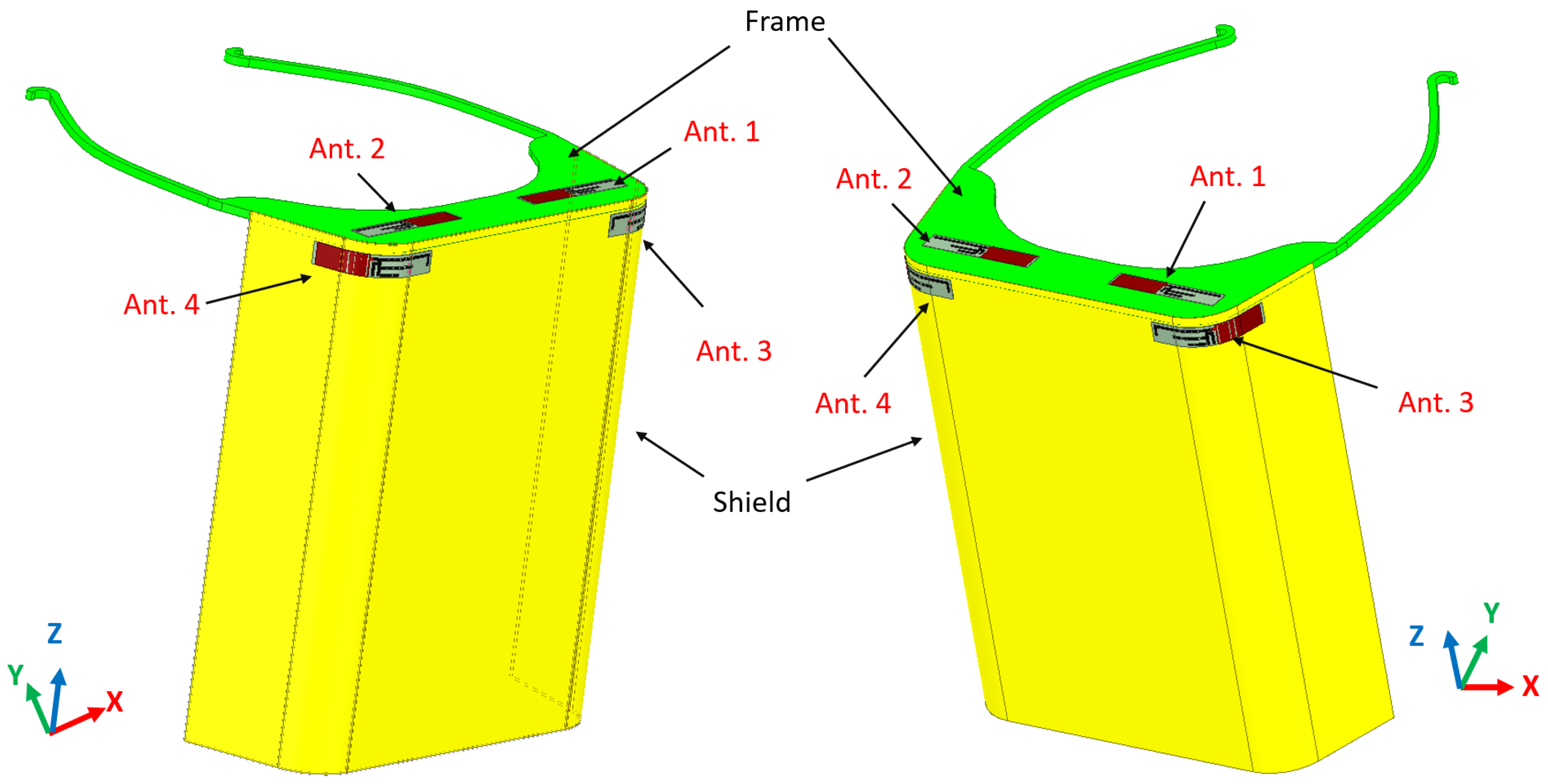

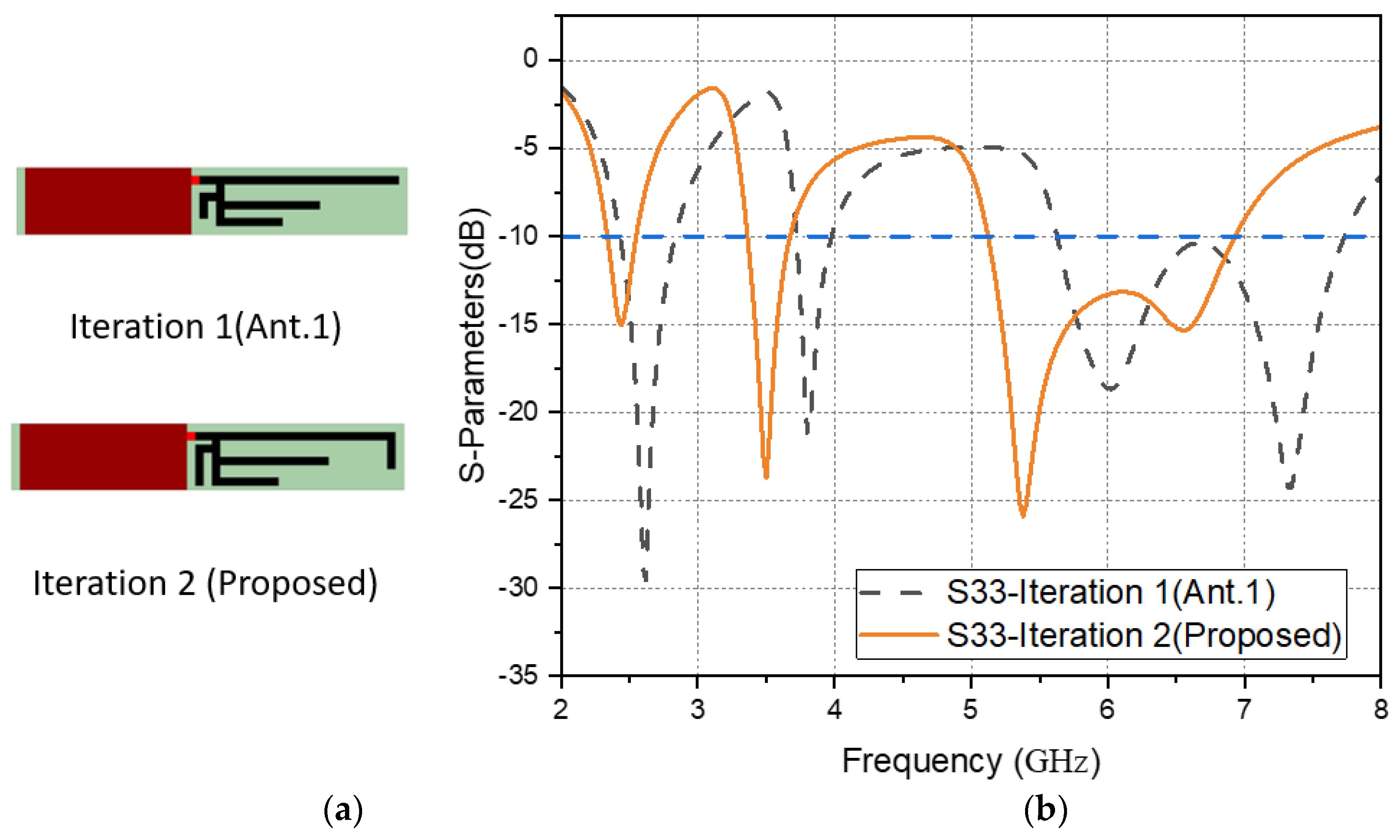
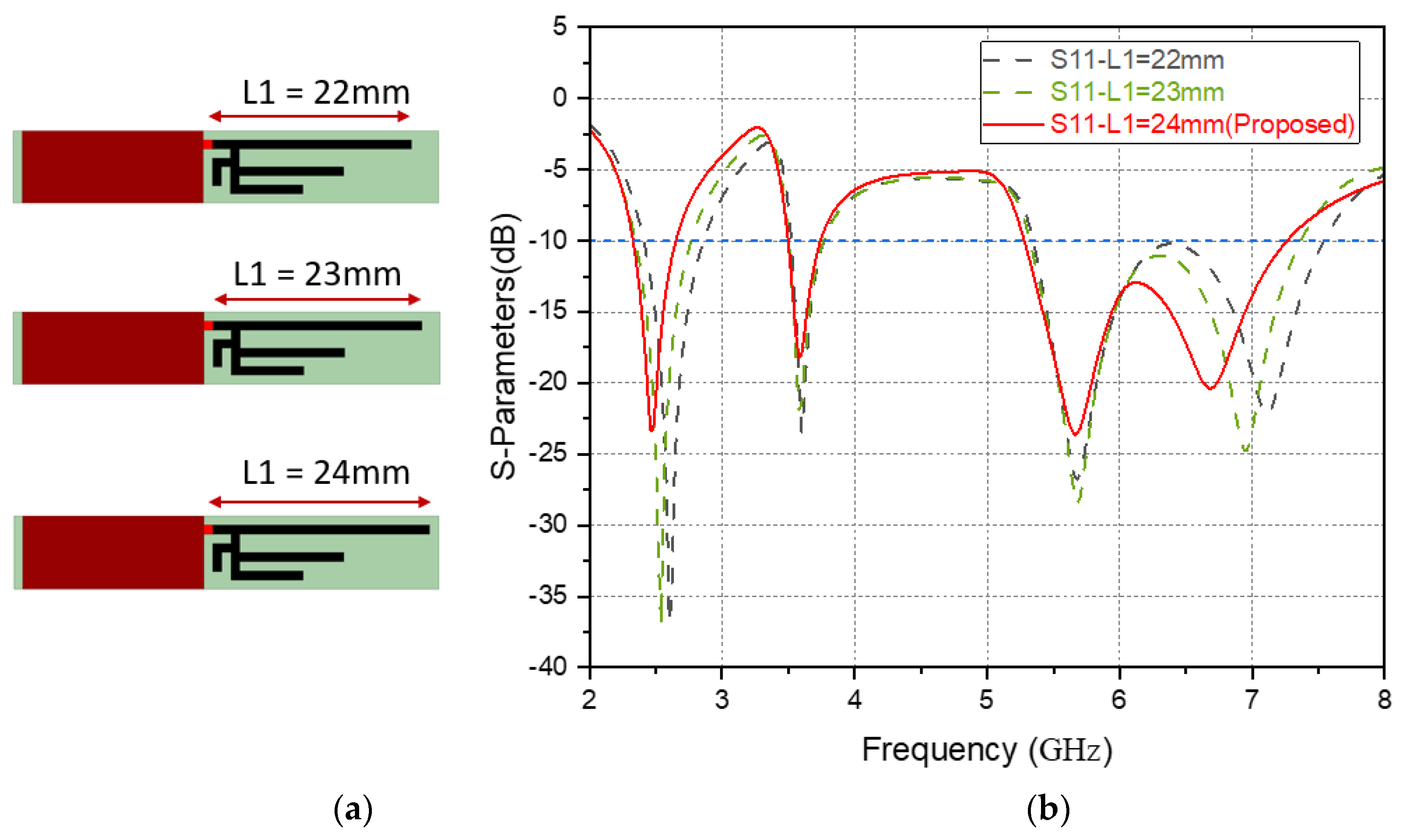
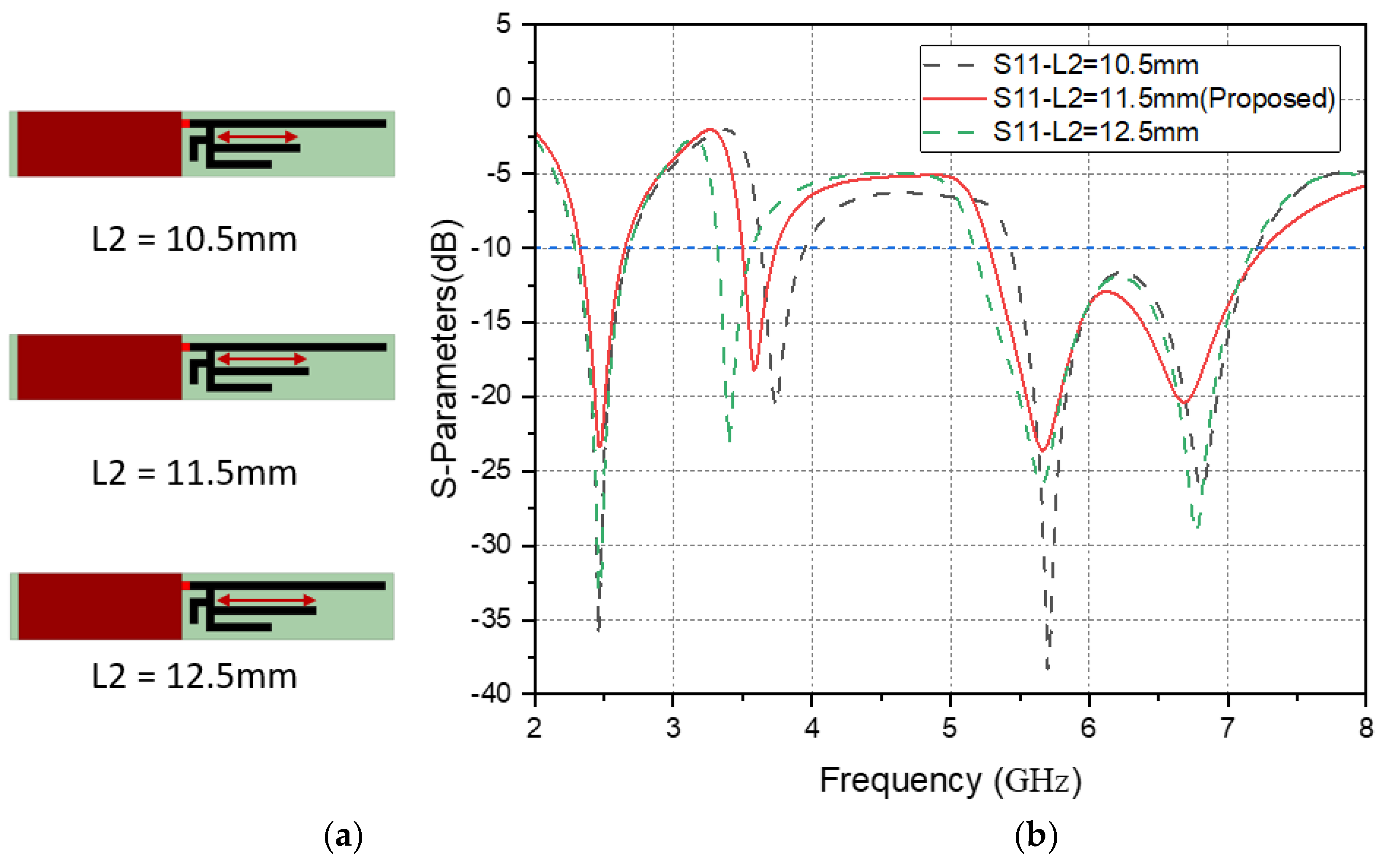
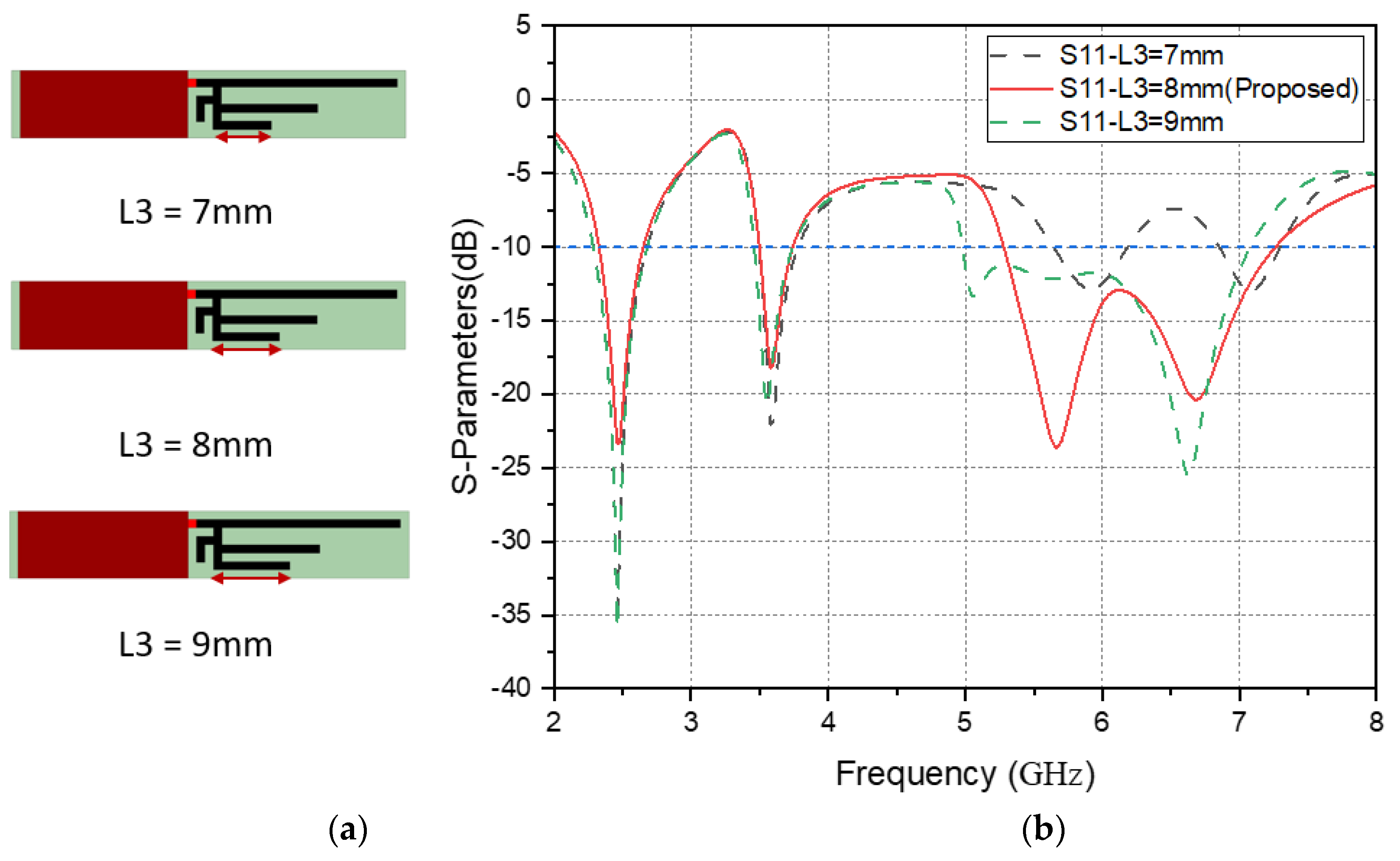

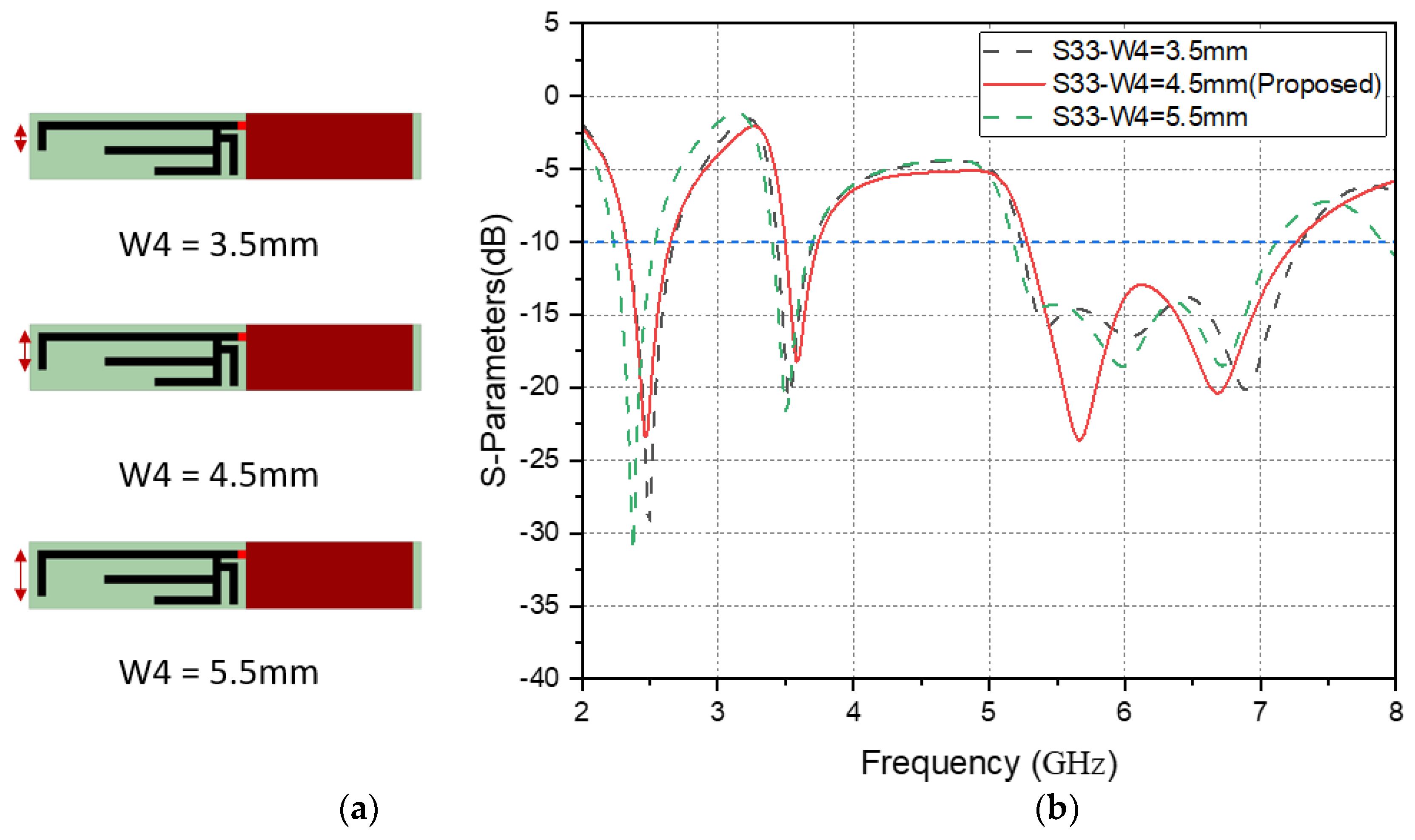

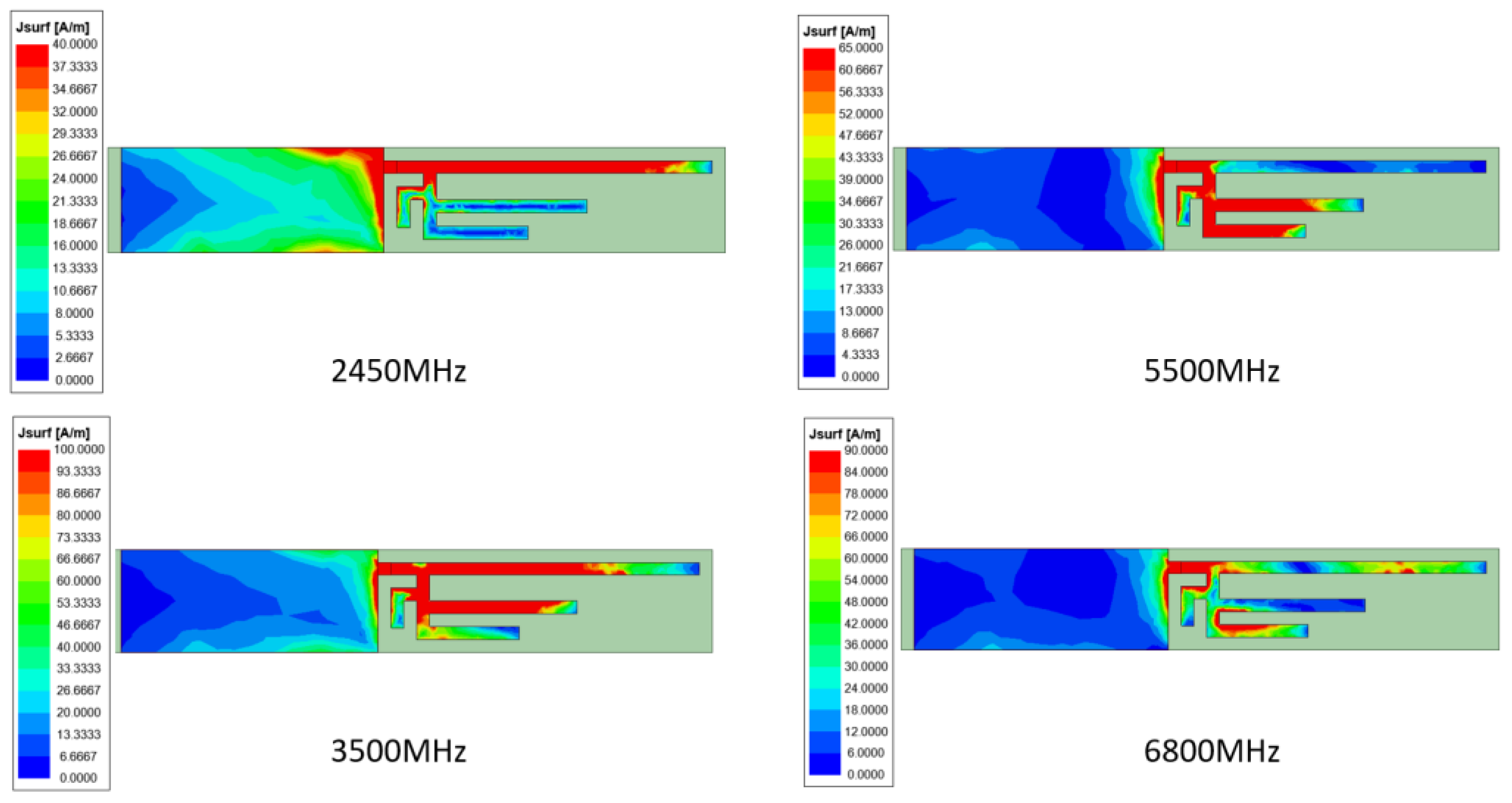
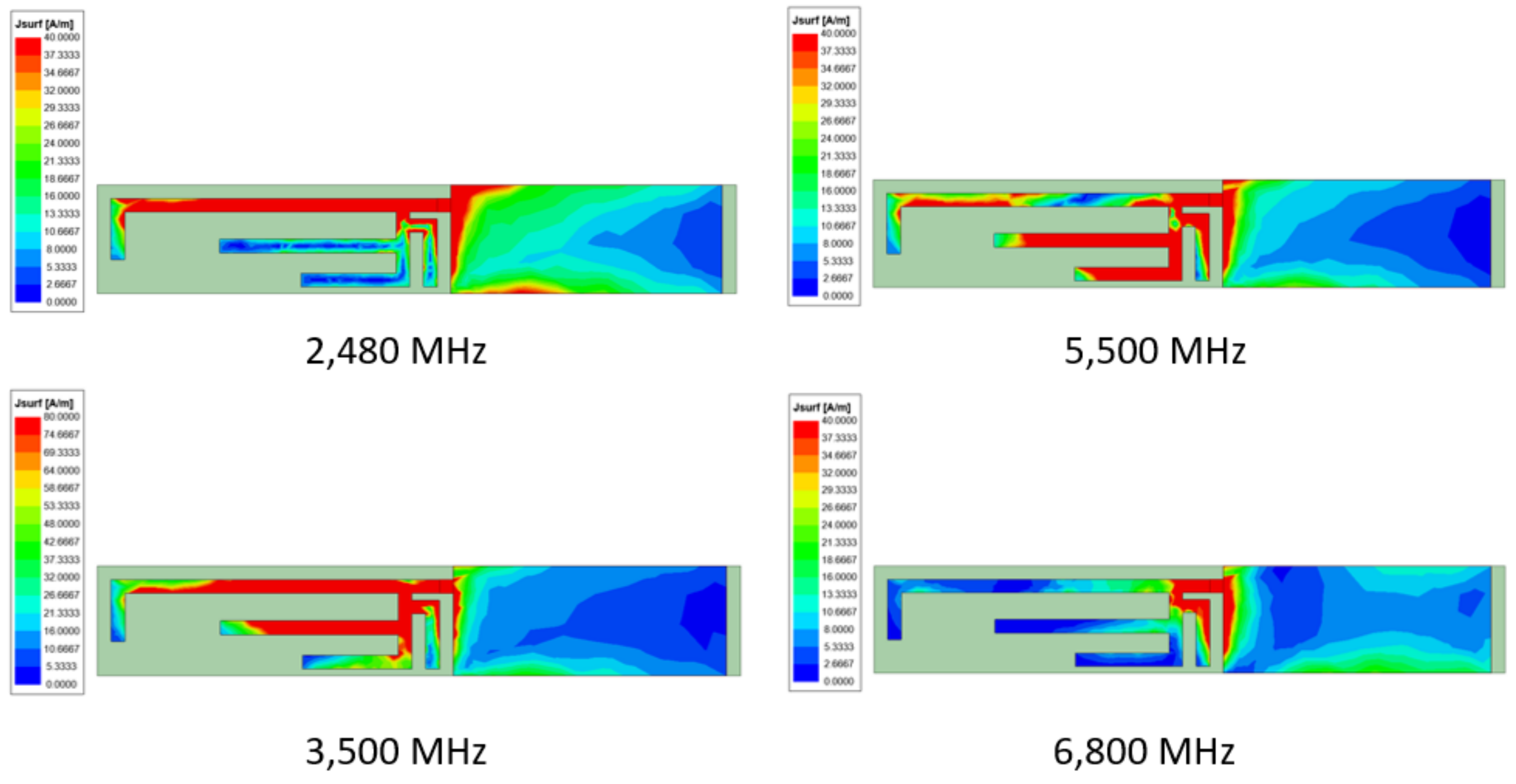
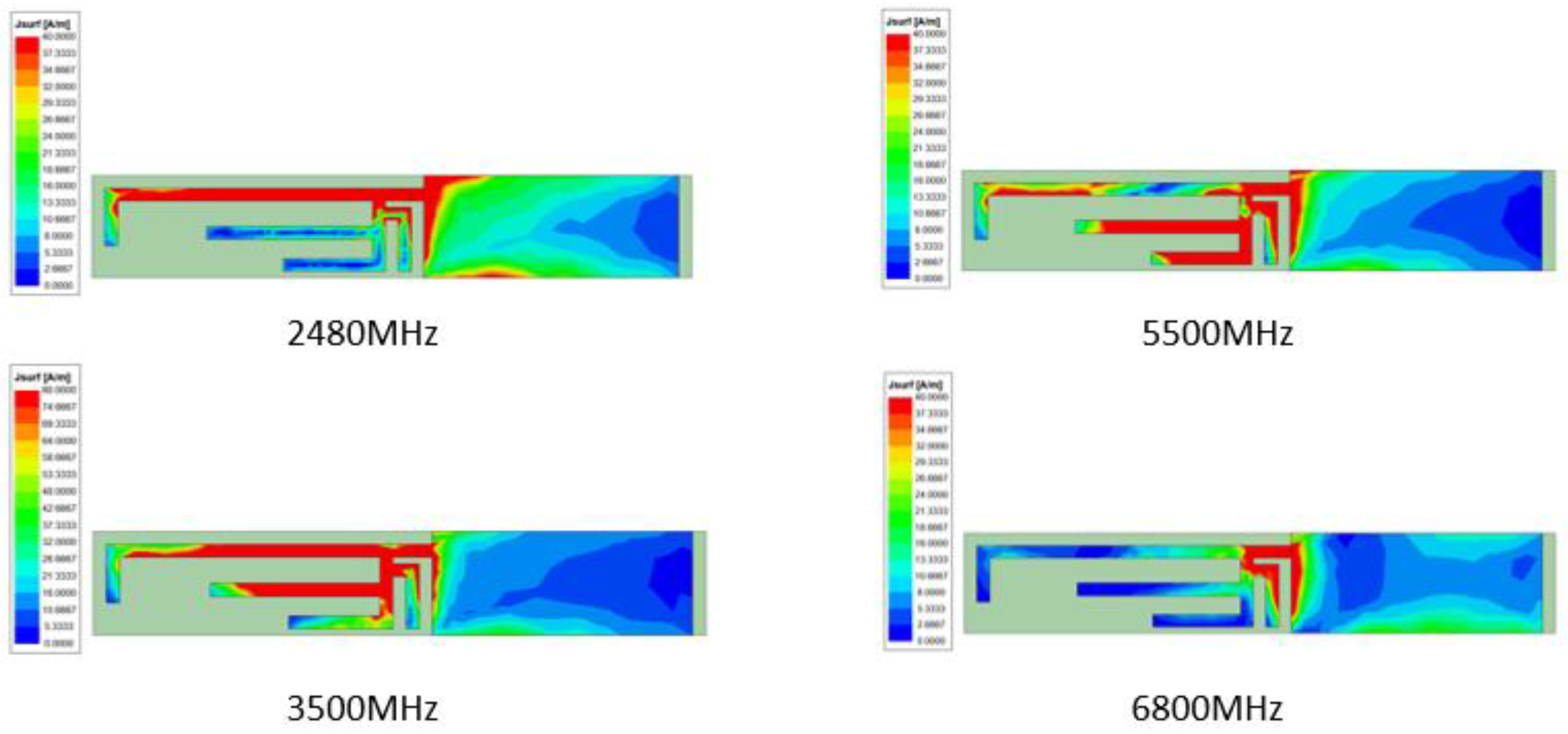
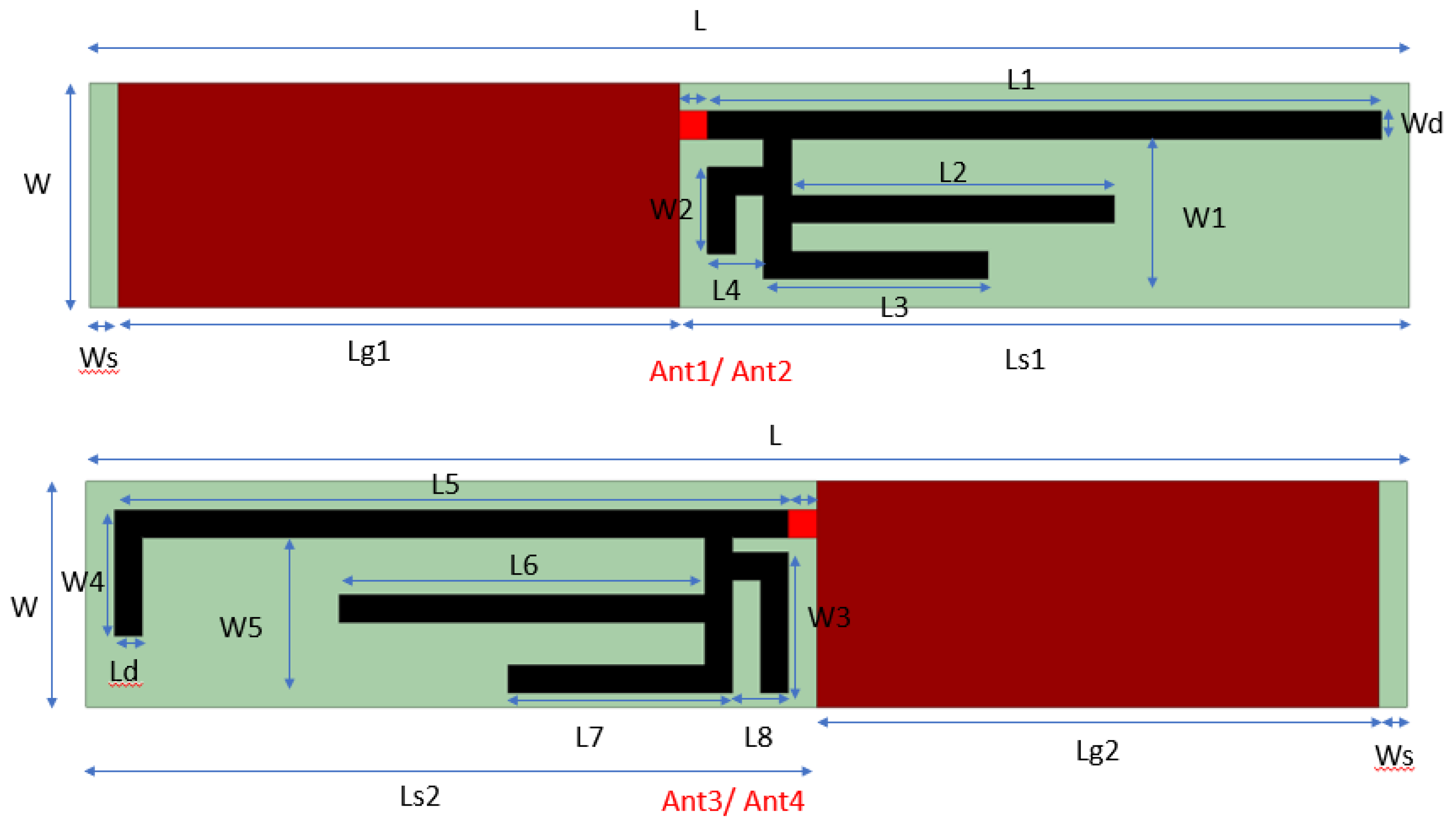
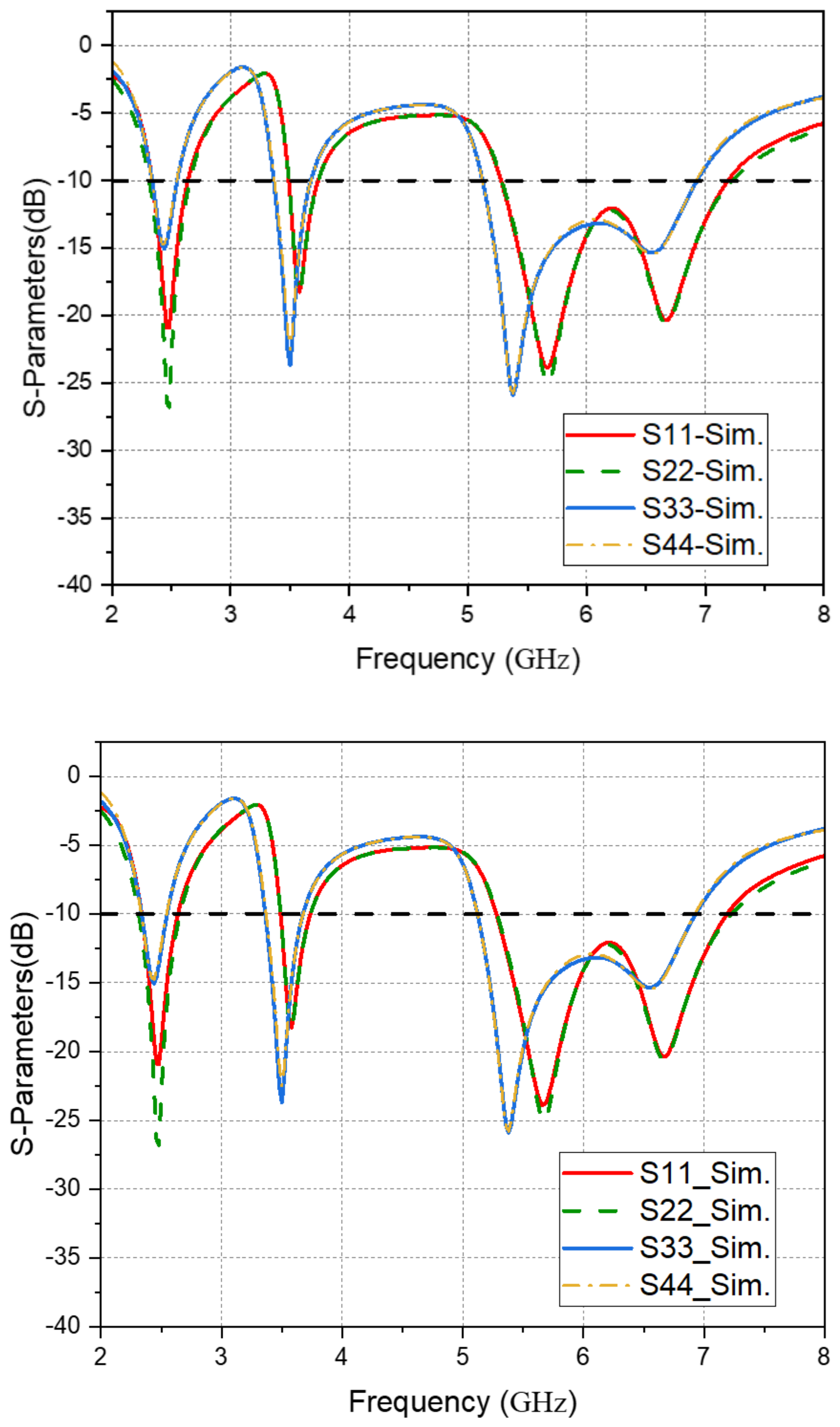




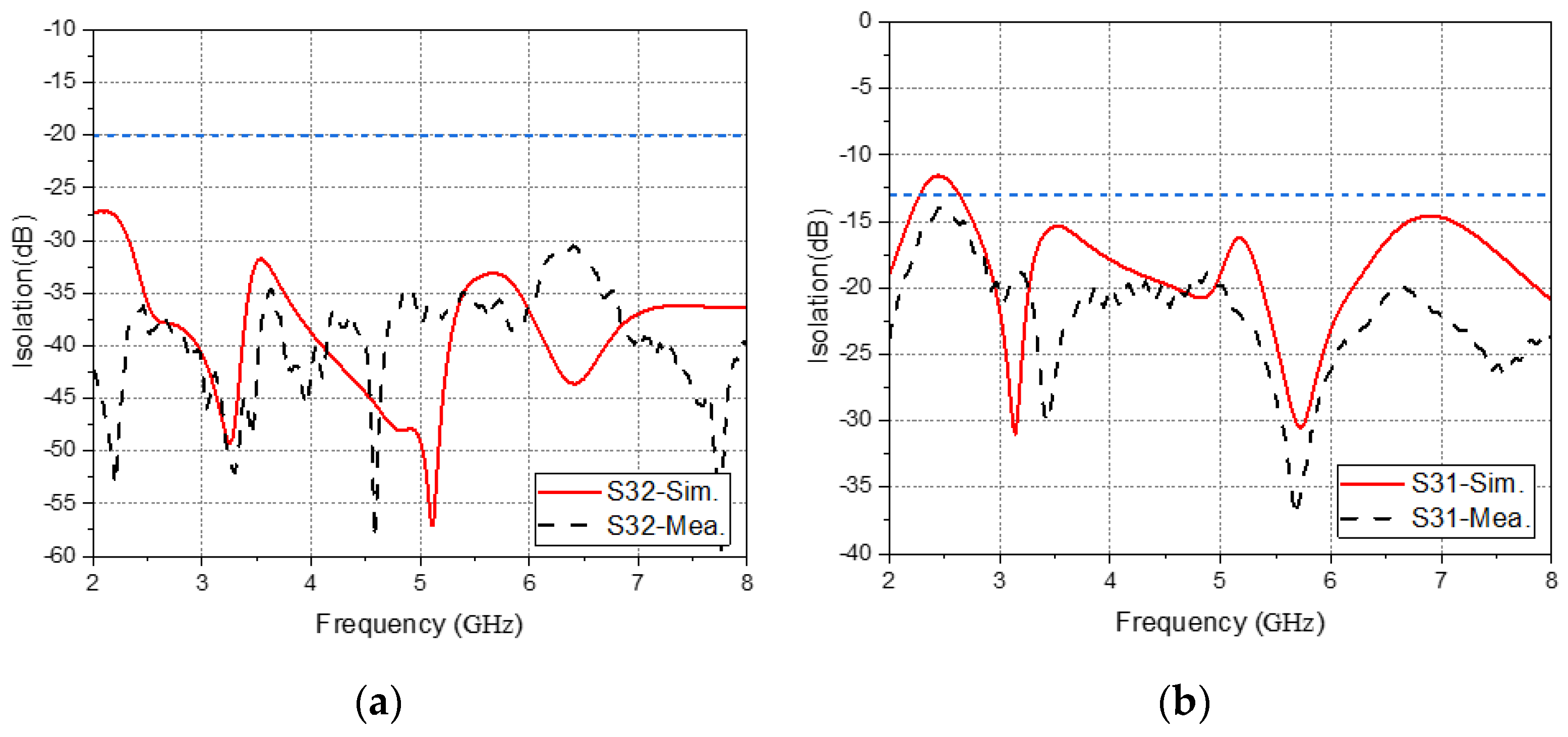

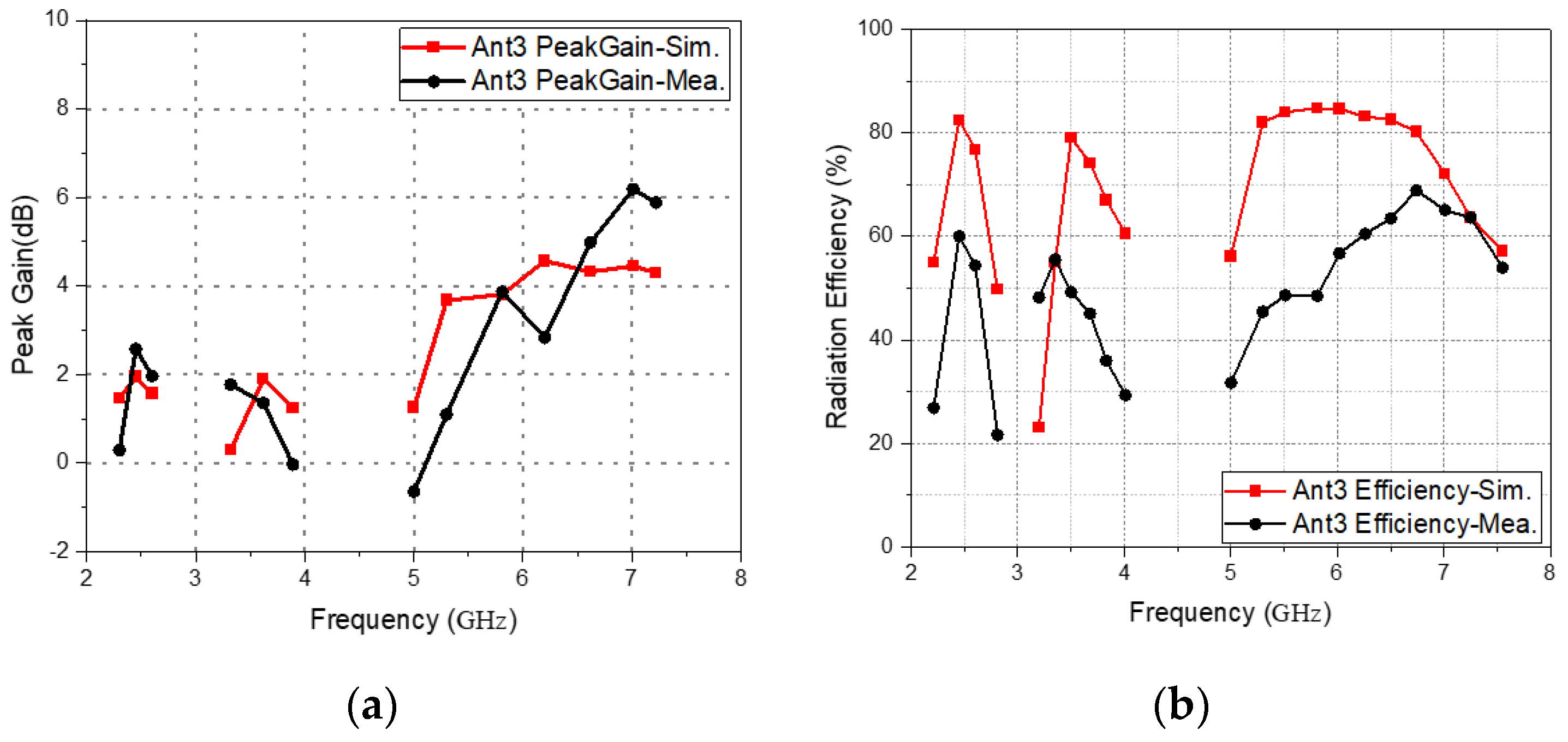

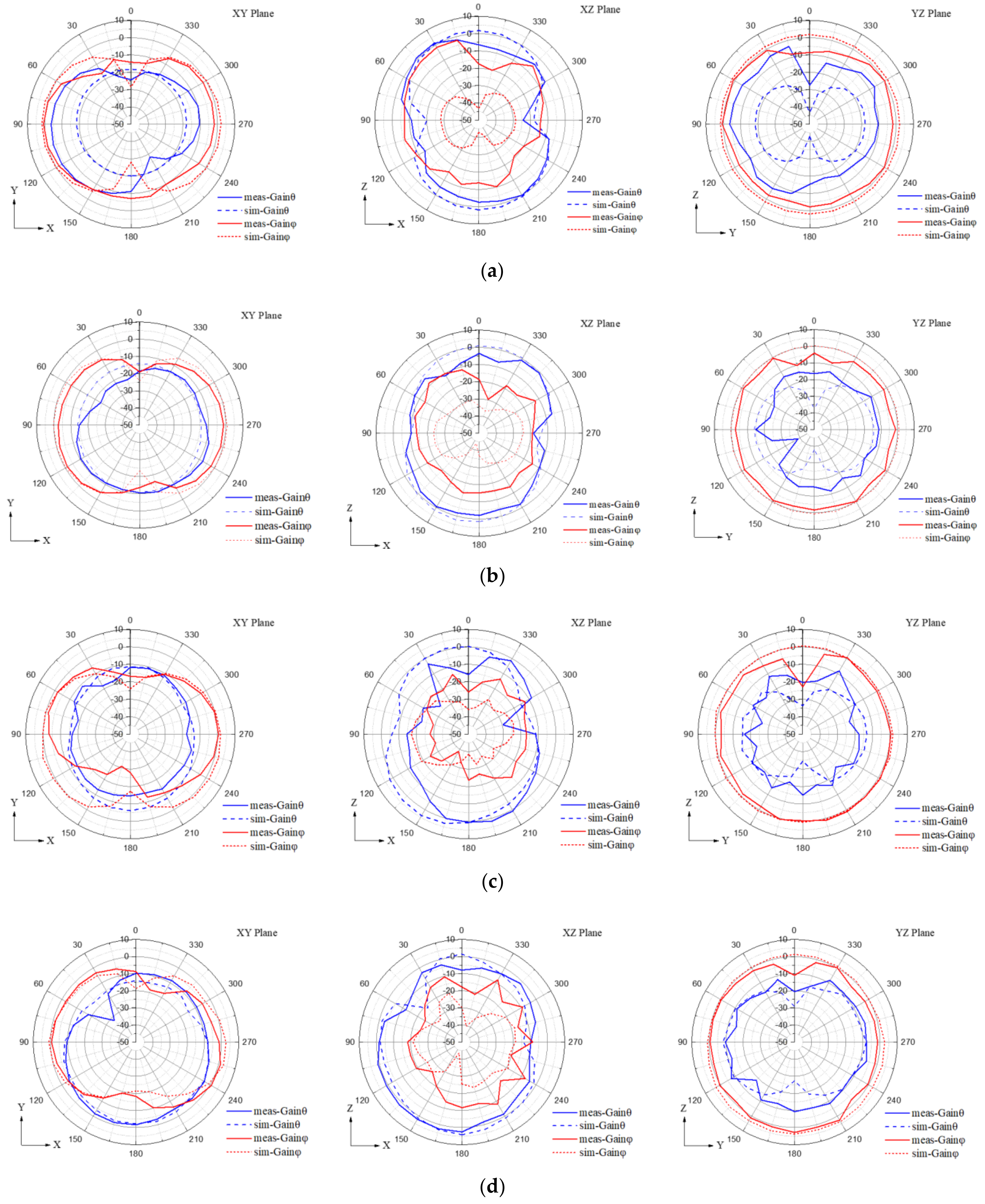
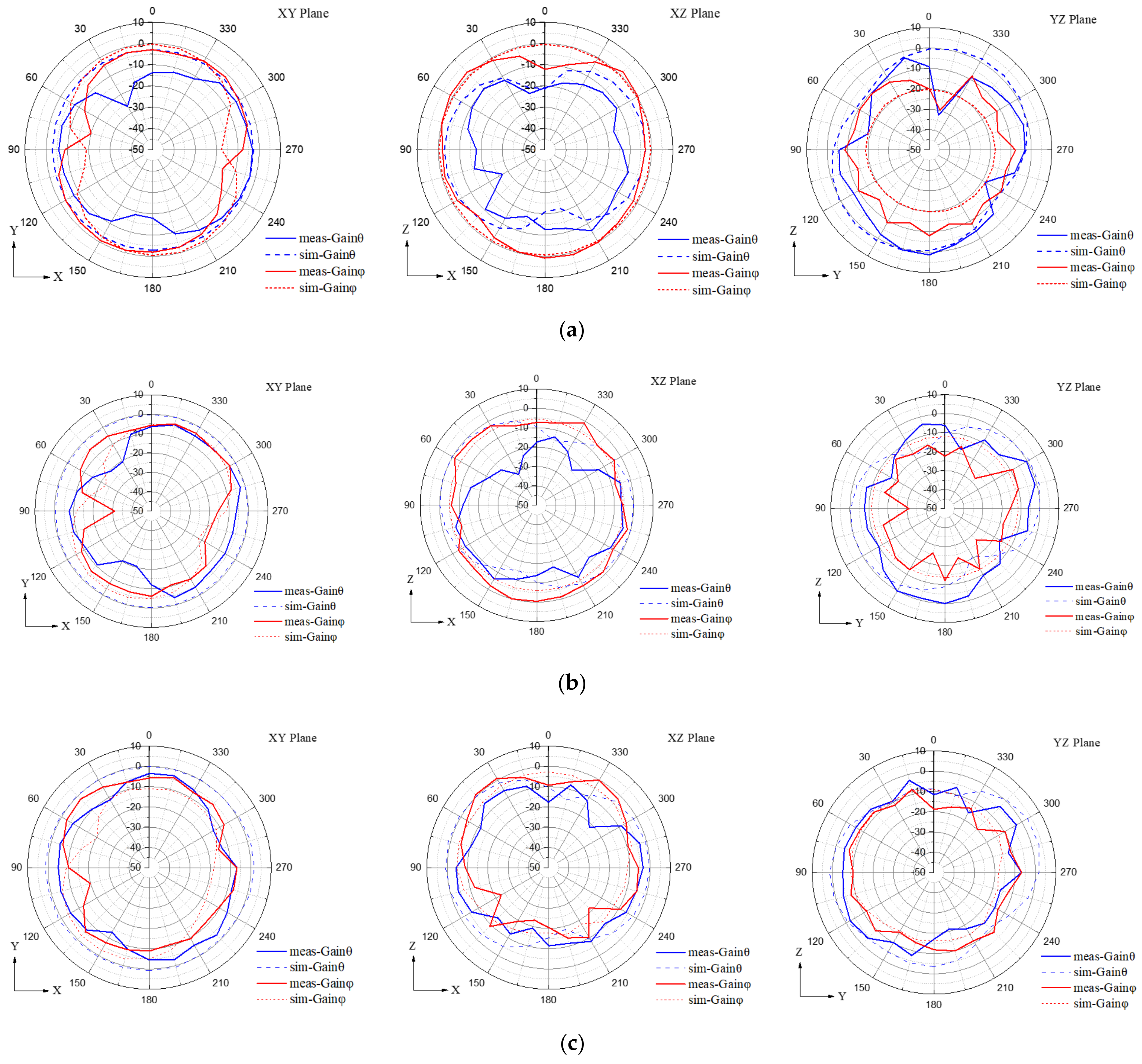

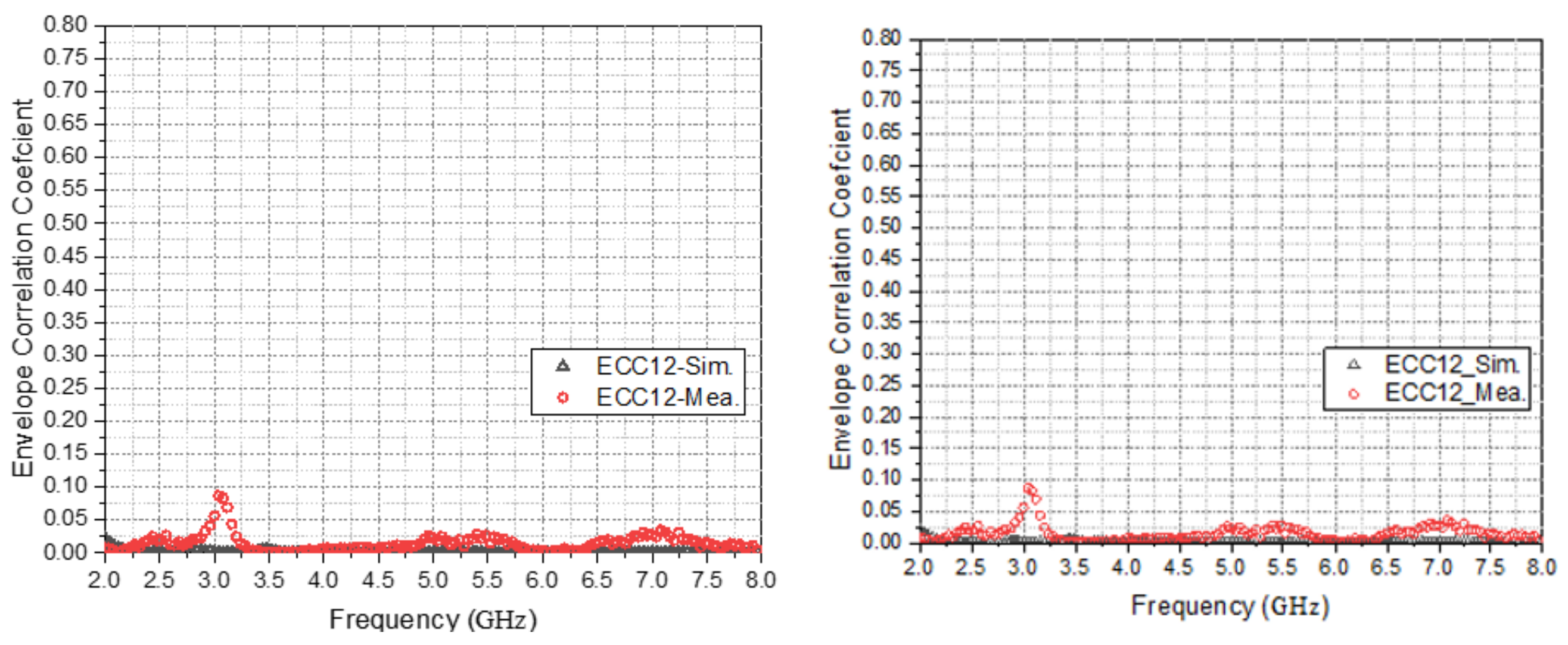
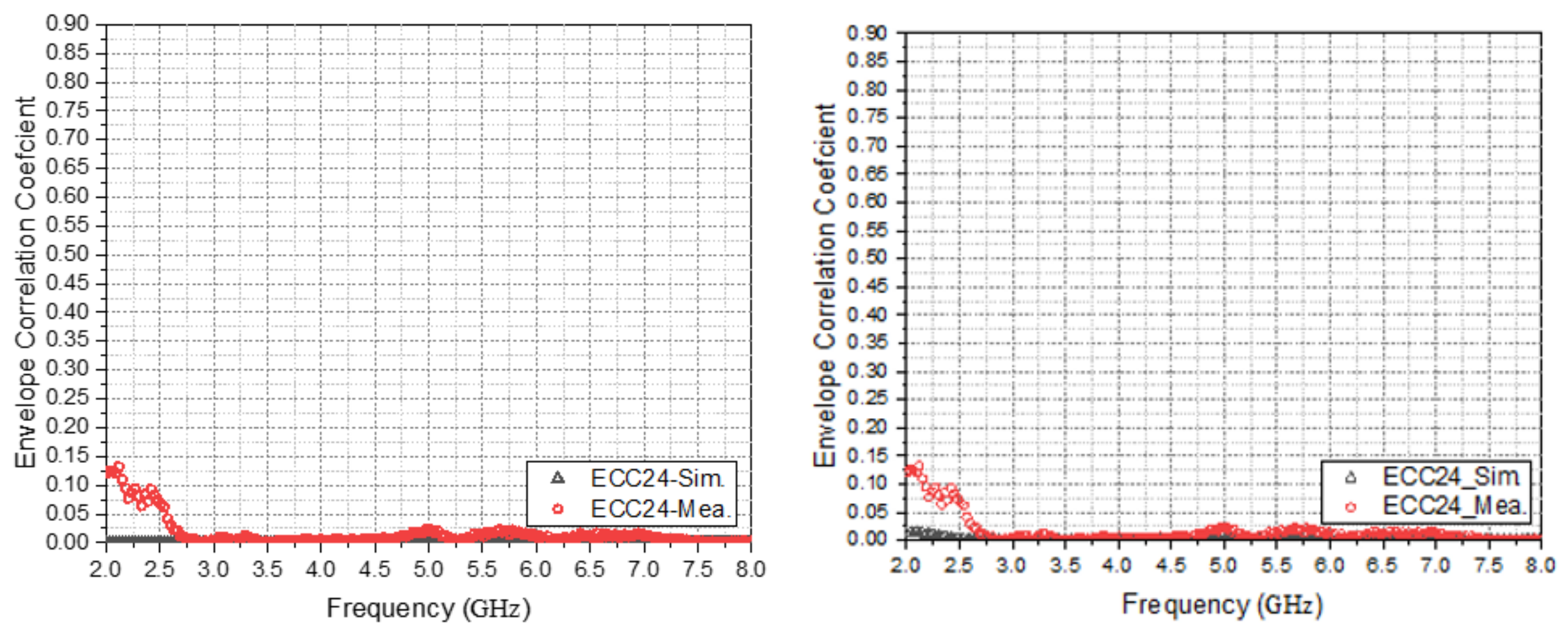
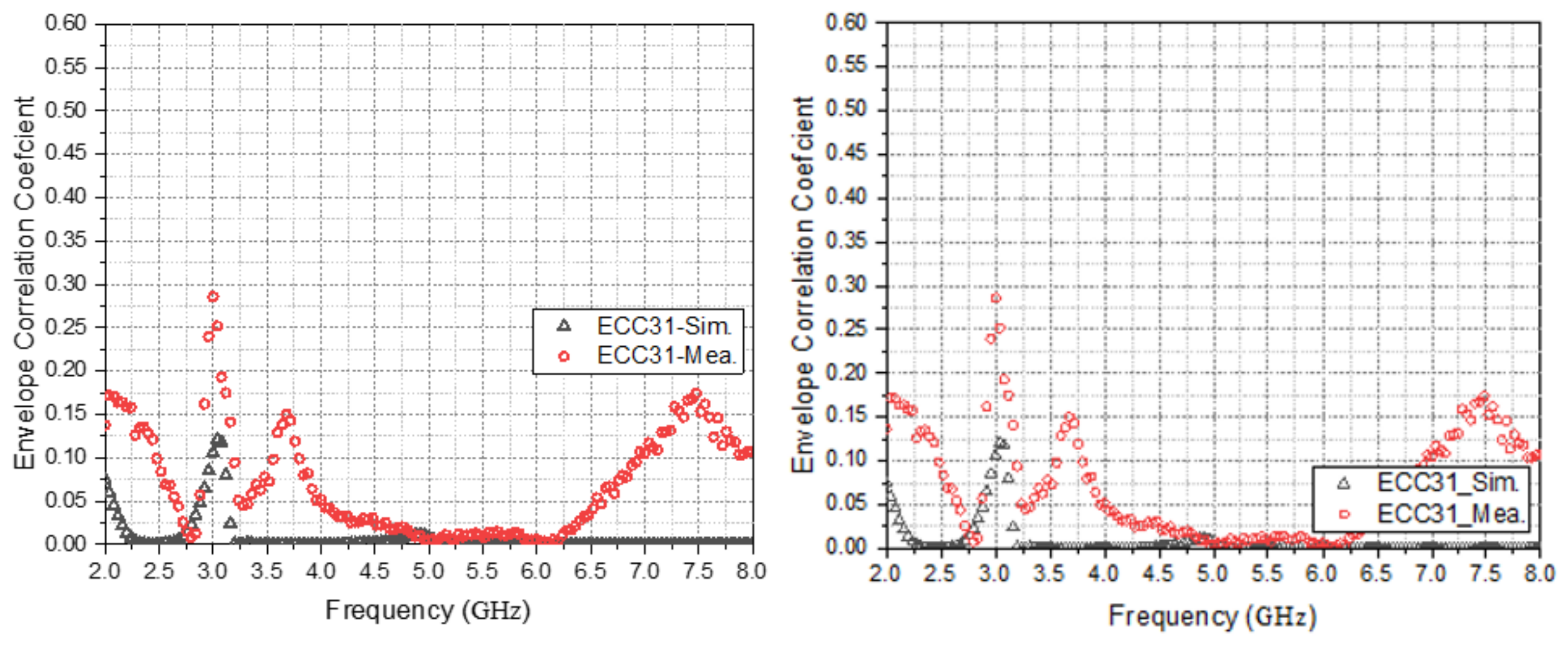
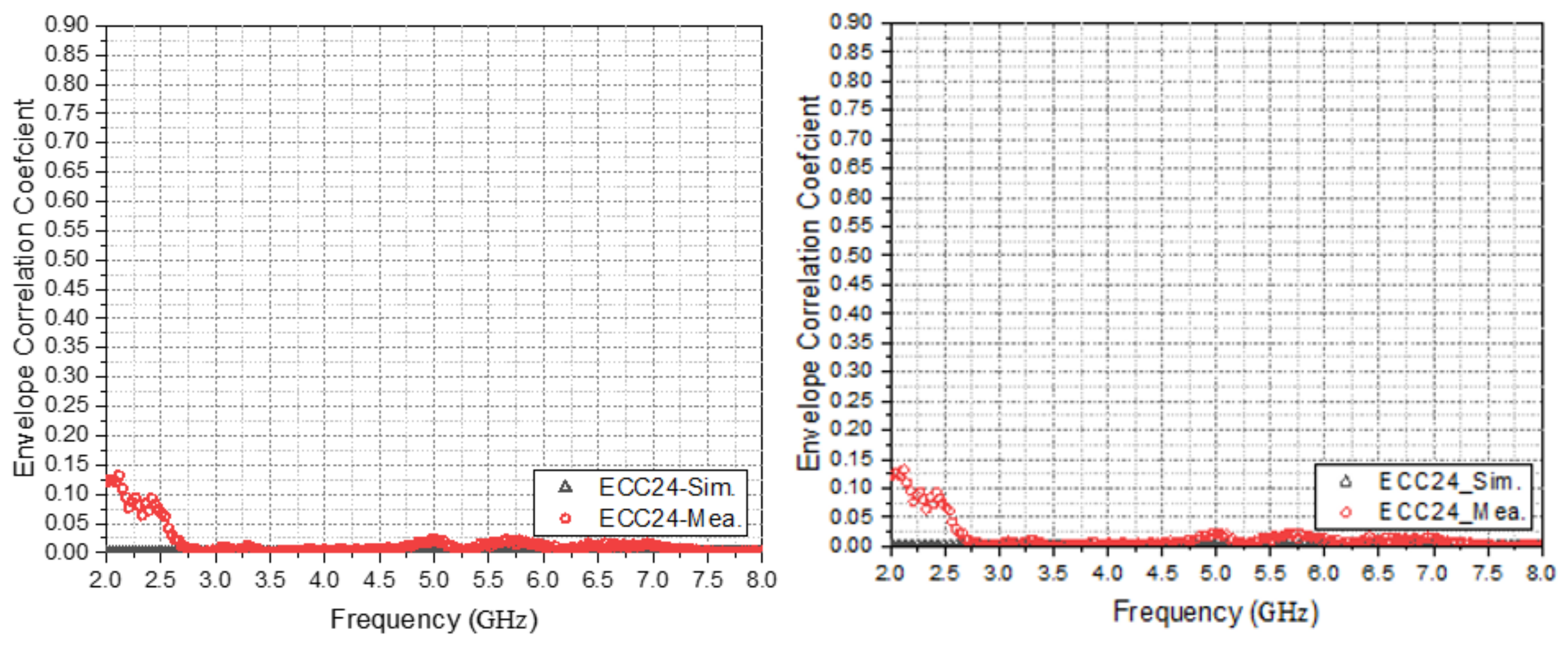
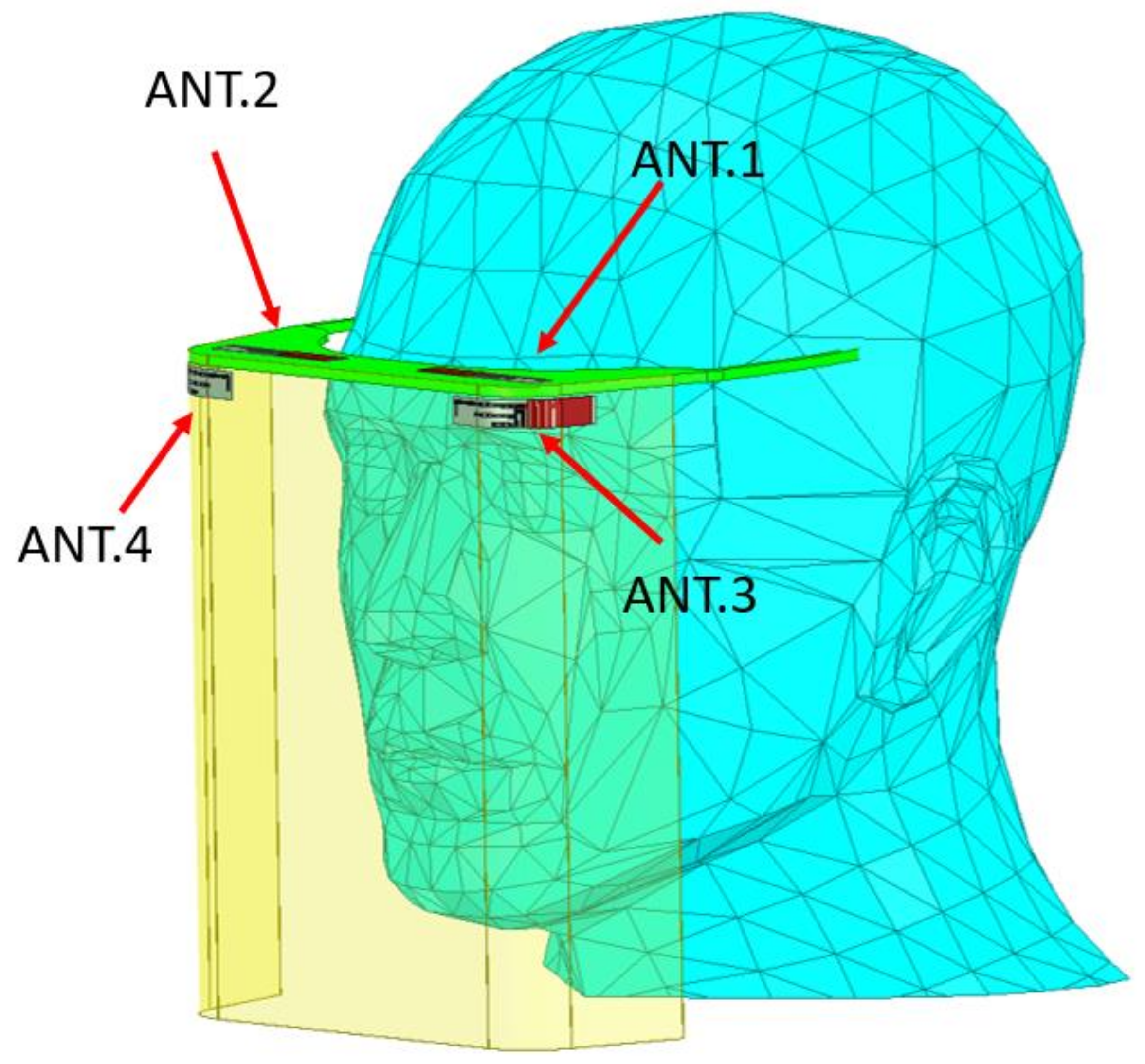

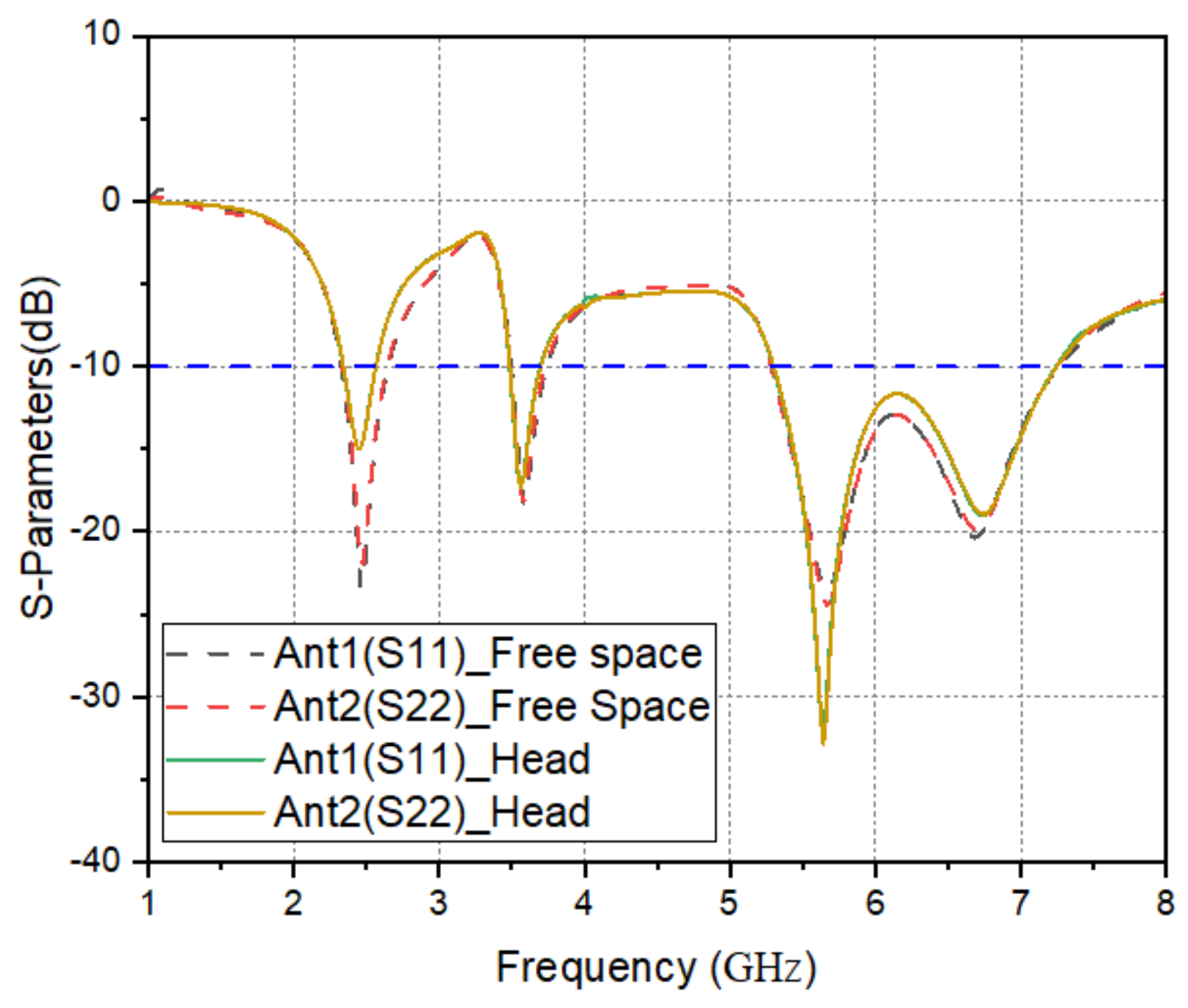

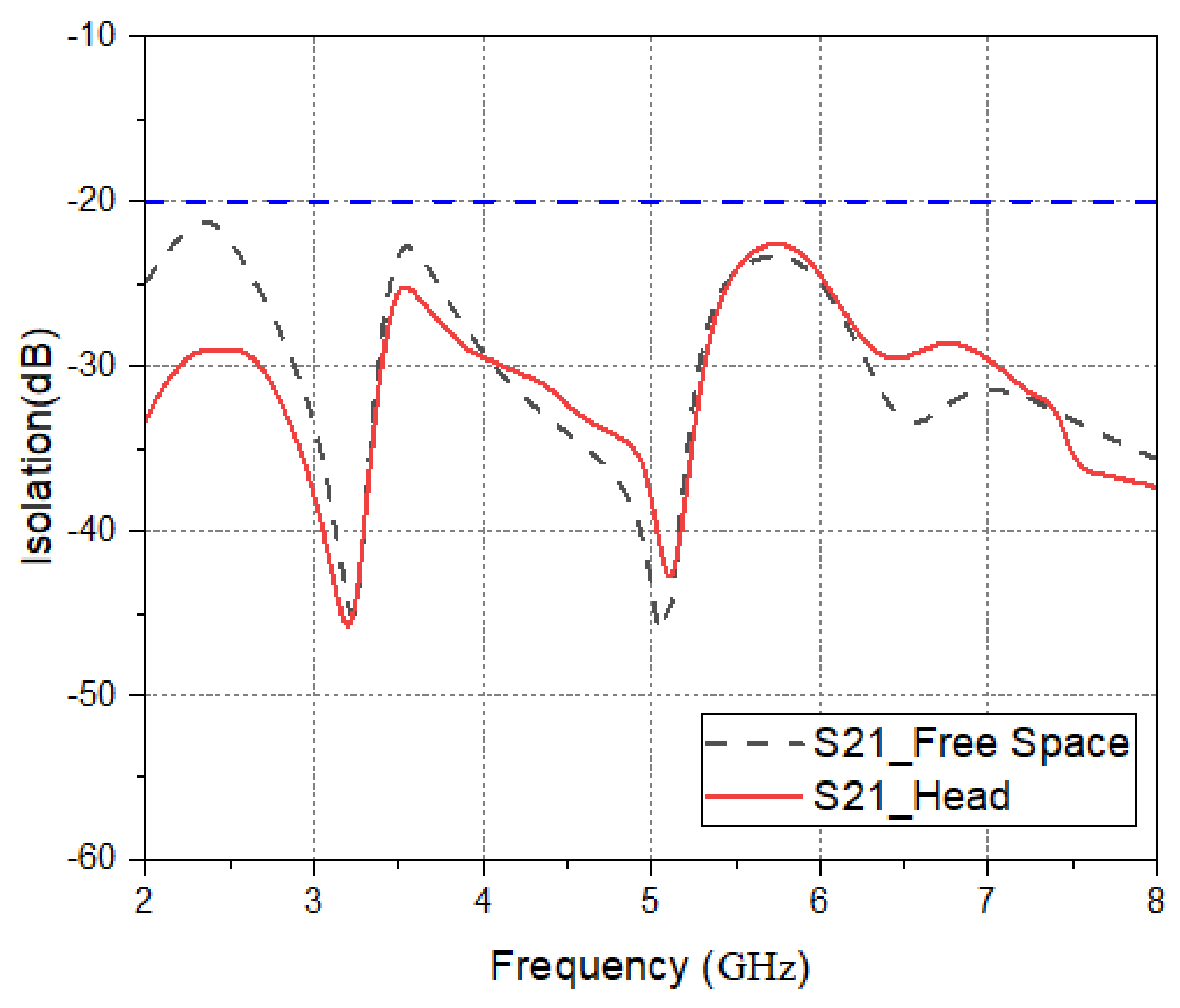

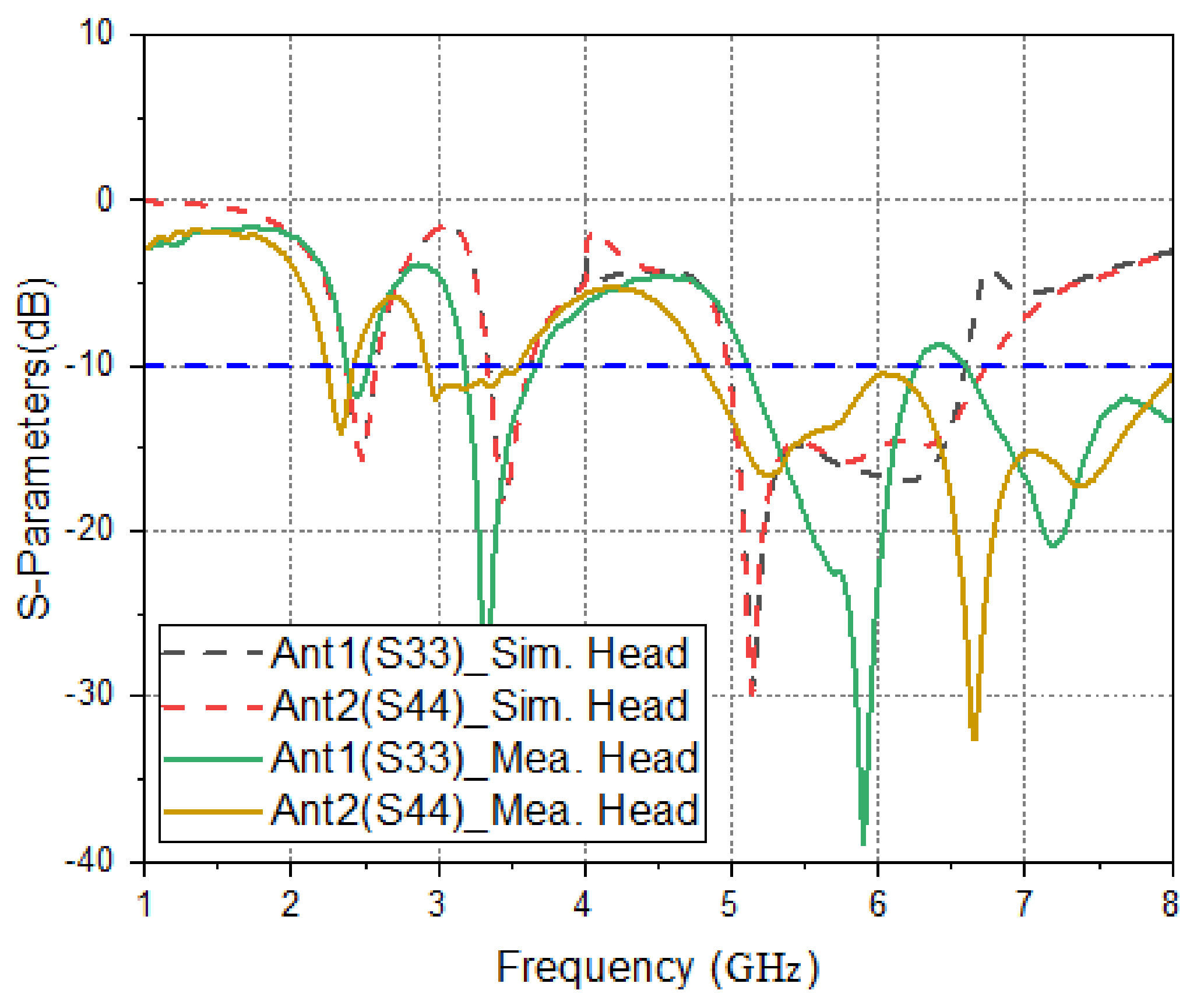
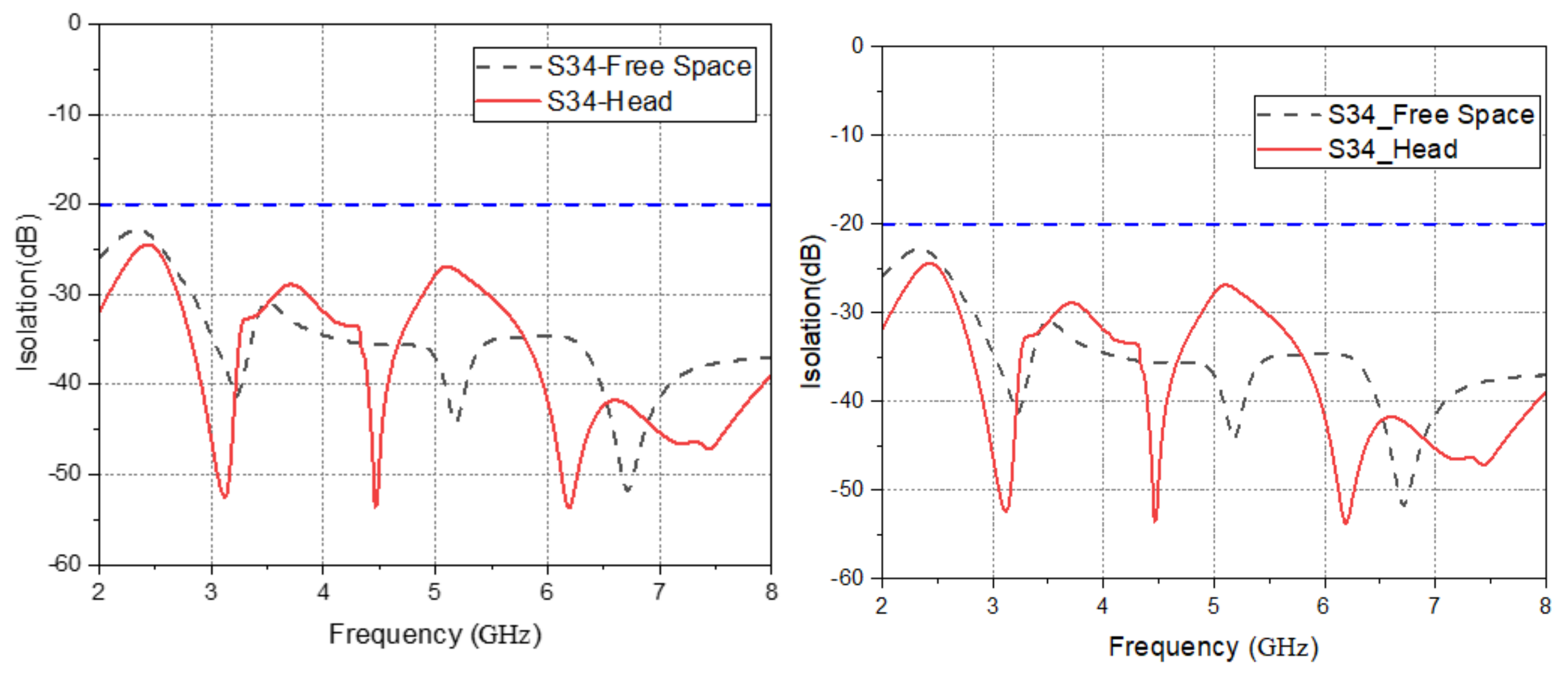
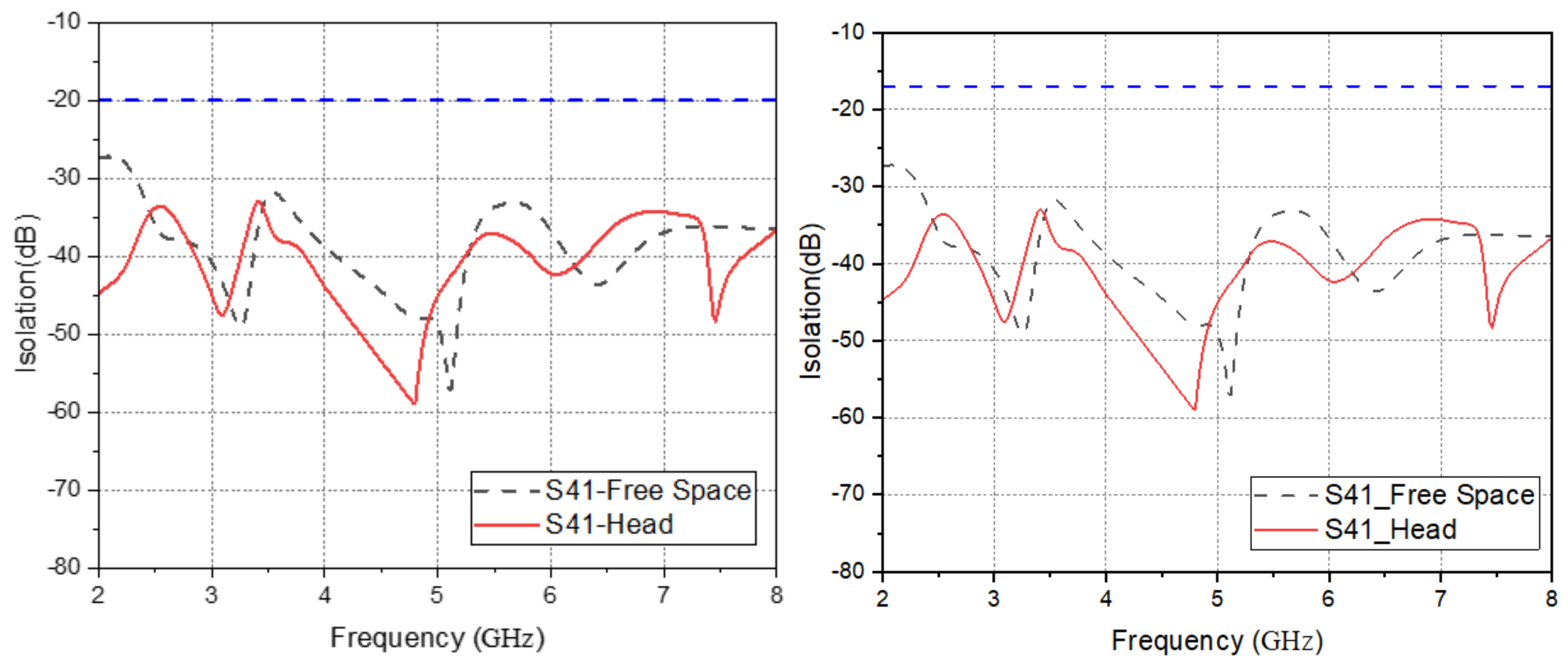
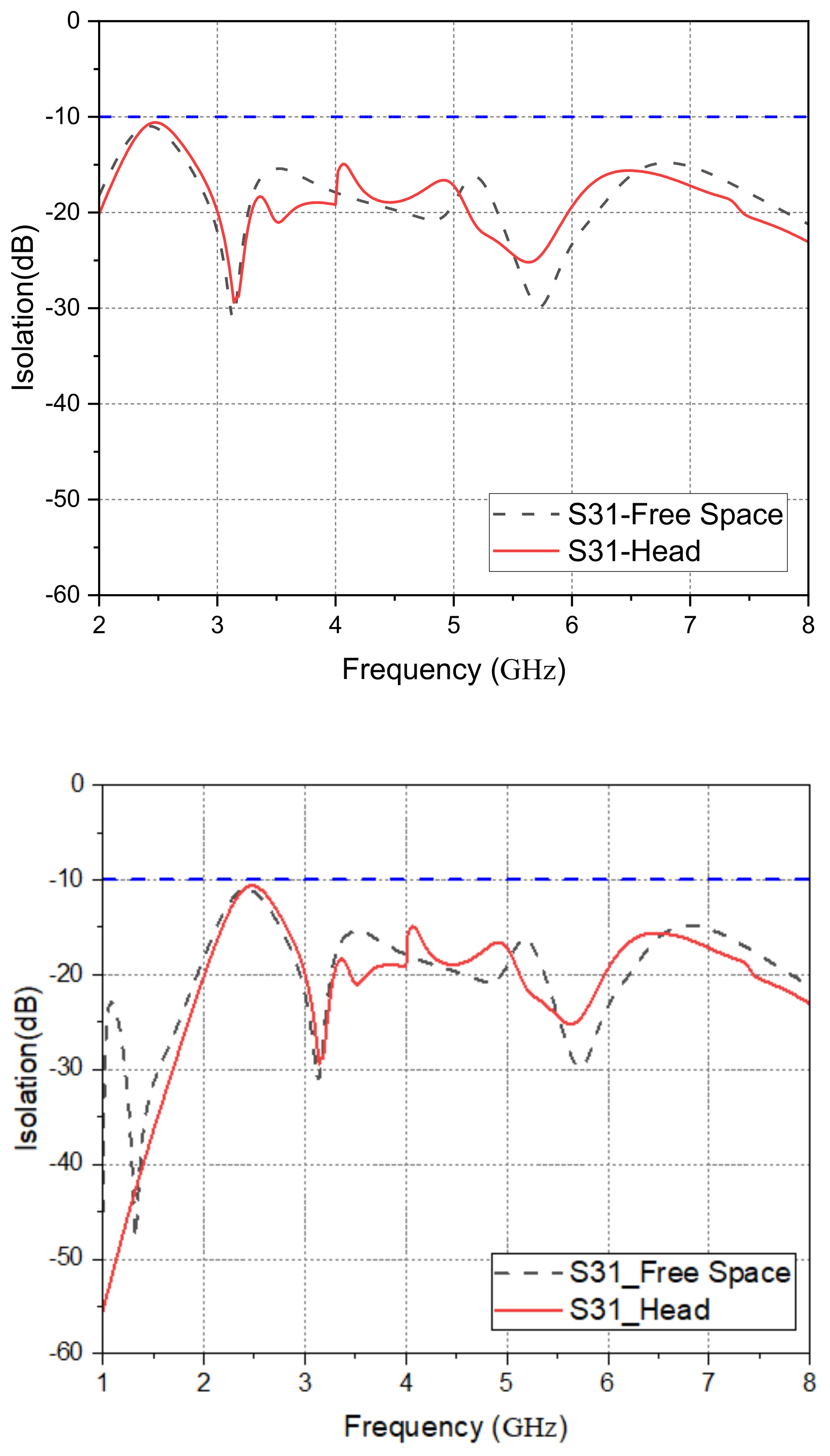

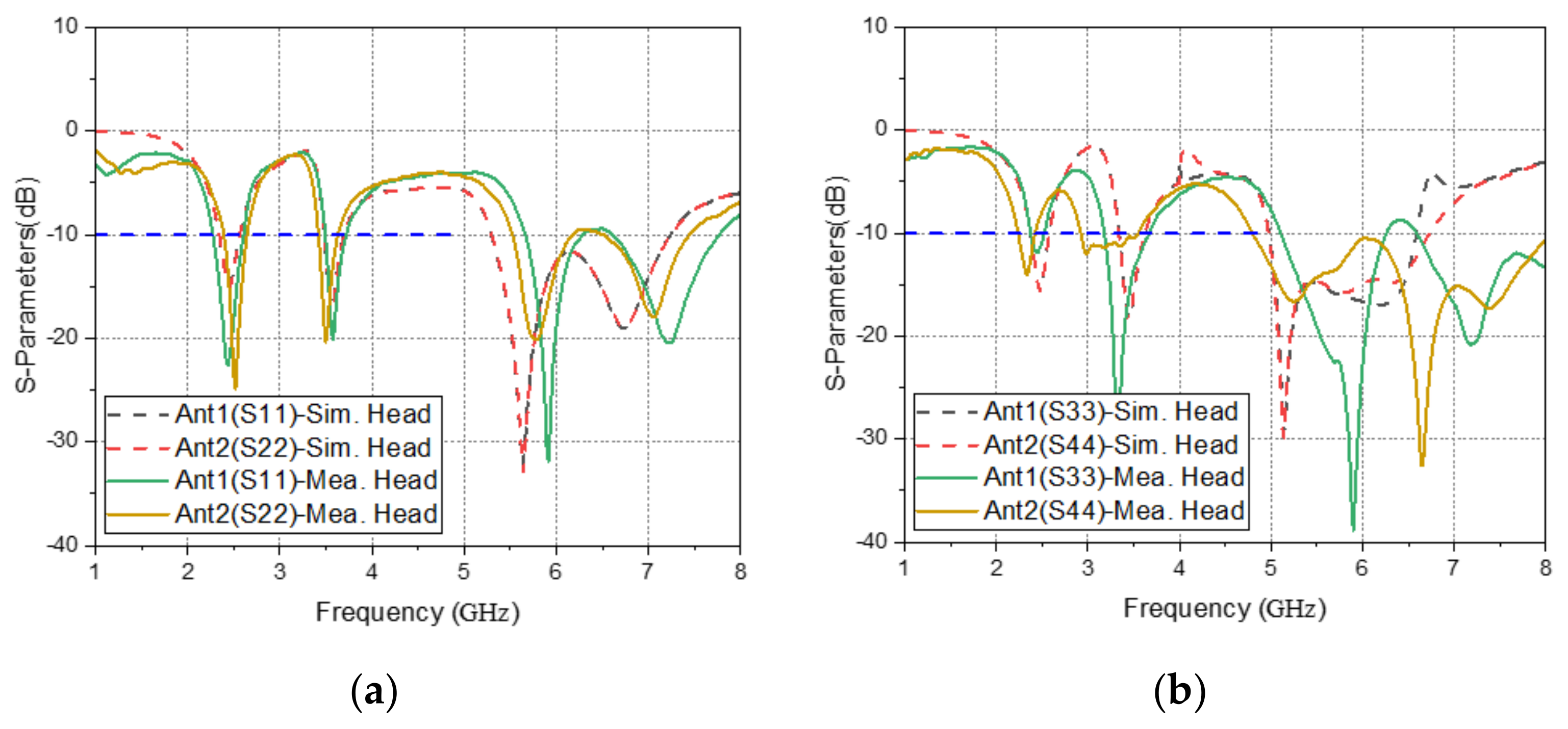
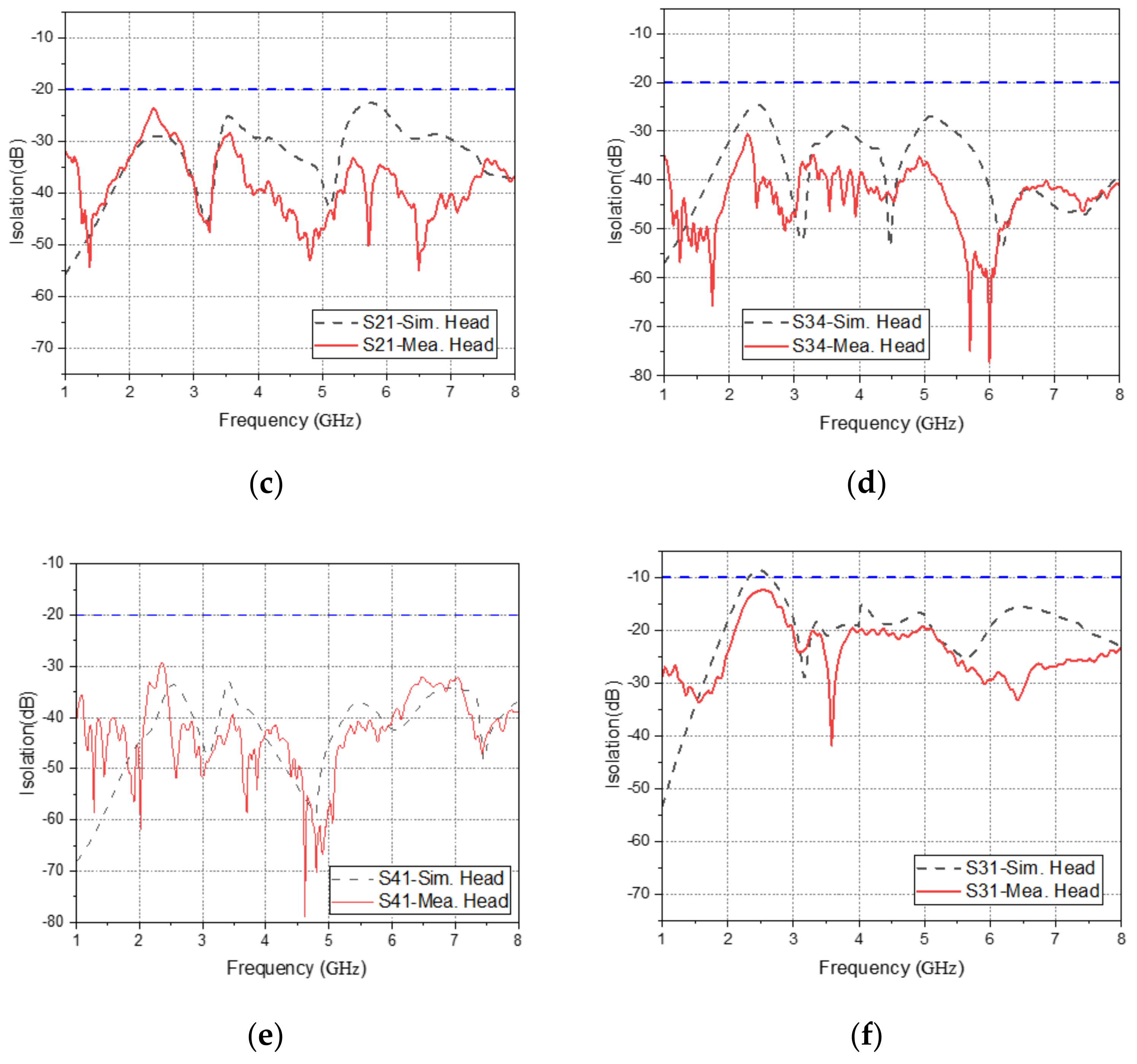




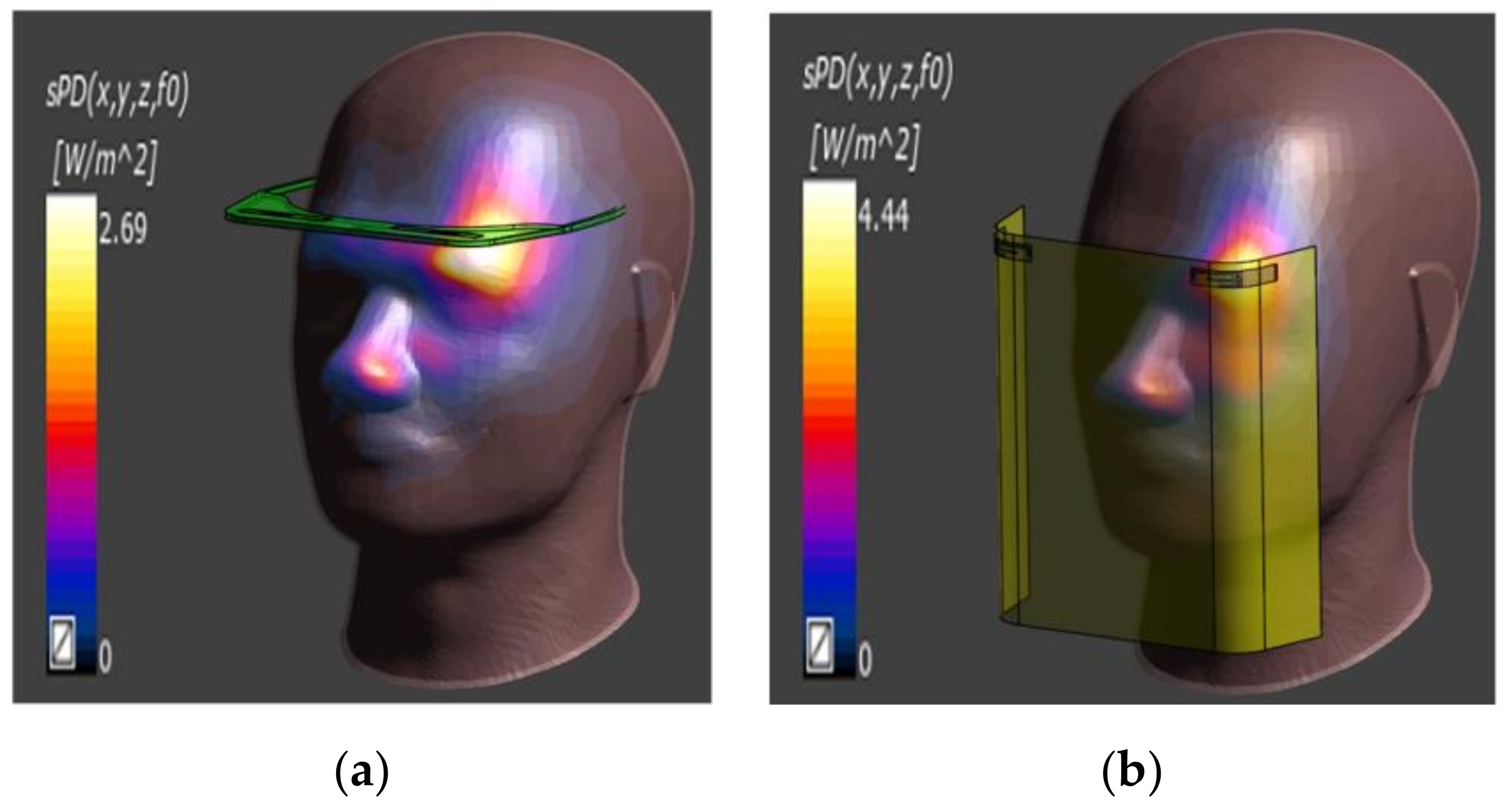
| ANT.1/ANT.2 | ANT.3/ANT.4 | ||||||
|---|---|---|---|---|---|---|---|
| Parameter | Value (mm) | Parameter | Value (mm) | Parameter | Value (mm) | Parameter | Value (mm) |
| L | 47 | W | 8 | L | 47 | W | 8 |
| Lg1 | 20 | Wd | 1 | Lg2 | 20 | W3 | 5 |
| Ls1 | 26 | Ws | 1 | Ls2 | 26 | W4 | 4.5 |
| L1 | 24 | W1 | 5 | L5 | 24 | W5 | 5.5 |
| L2 | 11.5 | W2 | 3 | L6 | 13 | ||
| L3 | 8 | L7 | 8 | ||||
| L4 | 2 | L8 | 2 | ||||
| Ld | 1 | ||||||
| ANT.1 | ANT.3 | ||||
|---|---|---|---|---|---|
| Frequency | 1 g SAR | 10 g SA | Frequency | 1 g SAR | 10 g SA |
| 2.4 GHz | 0.297 | 0.193 | 2.4 GHz | 0.118 | 0.0776 |
| 3.5 GHz | 0.207 | 0.139 | 3.5 GHz | 0.214 | 0.14 |
| 5.5 GHz | 0.235 | 0.135 | 5.5 GHz | 0.158 | 0.122 |
| 6.8 GHz | 0.146 | 0.108 | 6.8 GHz | 0.244 | 0.16 |
| Ref. | Size (mm) | Applied to | Operating Band/BW | Efficiency (%) | Gain (dBi) | MIMO | Material |
|---|---|---|---|---|---|---|---|
| [12] | 17 × 25 × 0.787 | Human Body | 2.4 GHz 1.62–3 GHz | 93% | 2.5 | N.A. | RT/duroid 5880 |
| [13] | 6 ×6 × 1 | Glasses | 5.8 GHz 5.42–6.27 GHz | N.A. | 8.18 | N.A. | Rogers RO3203 |
| [14] | 15 × 40 | Human Wrist | 2.4 GHZ 2400–2500 MHz 5.8 GHz 5725–5875 MHz | 65%~76% 88% | 1.1~1.5 3.8~4.2 | N.A. | FR4 |
| [15] | 35 × 35 | Glasses | 2.4 GHz | 41% | 2.3~4.3 | N.A. | PLA |
| [16] | 60 × 10 | Helmet | 2.45 GHz 2400–2510 MHz | 80/63% | 1.5~2.45 | N.A. | FR4 |
| [17] | 100 × 10 × 1 | Glasses | 4G(LTE) 0.824–0.96 GHz 1.71–2.69 GHz 5G 3.3–3.6 GHz 4.8–5 GHz | 40~49% 53~71% 30~57% 51~54% | 0.4–2.7 0.6–3.7 0.8–5.2 4.8–5.2 | 2 × 2 4 × 4 | FR4 |
| [18] | 29 × 29 × 0.8 | Smartwatch | LTE2300 2305–2400 MHz ISM2400 2400–2500 MHz LTE2600 2500–2690 MHz WiMAX3500 3500–3600 MHz WiMAX5200 5200–5300 MHz ISM5800 5750–5850 MHz | 70% | 6.9 | N.A. | FR4 |
| [19] | 25 × 25 × 1 | N.A. | 5 G FR1 3.3–6.57 GHz | 78~86% | 1.86~2.3 | N.A. | FR4 |
| [20] | 166 × 101 × 40 | Glasses | 900 MHz 810–1070 MHz 2.4 GHz 1680–2700 MHz | N.A. | 0.6–1.8 1.5–3.9 | 2 × 2 | FR4 |
| [21] | 50 × 40.8 | Mobile | 1.8 GHz 1.74 GHz~1.88 GHz 3.5 GH 3.42 GHz~3.6 GHz 5.4 GHz. 5.34 GHz~5.54 GHz | 73% 68% 59% | 2.22 2.22 1.38 | N.A. | FR4 |
| This work | 47 × 8 × 0.2 | Medical Mask | Wi-Fi 7 2.38~2.62 GHz 5.14~8 GHz 5G FR1 3.38~3.74 GHz | 60% 71% 52% | 2.7 4.13 1.3 | 4 × 4 | FR4&PC FR4&PET |
Publisher’s Note: MDPI stays neutral with regard to jurisdictional claims in published maps and institutional affiliations. |
© 2022 by the authors. Licensee MDPI, Basel, Switzerland. This article is an open access article distributed under the terms and conditions of the Creative Commons Attribution (CC BY) license (https://creativecommons.org/licenses/by/4.0/).
Share and Cite
Chung, M.-A.; Lee, M.-C.; Hsiao, C.-W. Antenna Systems in Medical Masks: Applications for 5G FR1 and Wi-Fi 7 Wireless Systems. Electronics 2022, 11, 1983. https://doi.org/10.3390/electronics11131983
Chung M-A, Lee M-C, Hsiao C-W. Antenna Systems in Medical Masks: Applications for 5G FR1 and Wi-Fi 7 Wireless Systems. Electronics. 2022; 11(13):1983. https://doi.org/10.3390/electronics11131983
Chicago/Turabian StyleChung, Ming-An, Ming-Chang Lee, and Cheng-Wei Hsiao. 2022. "Antenna Systems in Medical Masks: Applications for 5G FR1 and Wi-Fi 7 Wireless Systems" Electronics 11, no. 13: 1983. https://doi.org/10.3390/electronics11131983
APA StyleChung, M.-A., Lee, M.-C., & Hsiao, C.-W. (2022). Antenna Systems in Medical Masks: Applications for 5G FR1 and Wi-Fi 7 Wireless Systems. Electronics, 11(13), 1983. https://doi.org/10.3390/electronics11131983






